Ossett - the history of a Yorkshire town
- ossett :
- Home :
- What's New :
- Picture Gallery :
- WW1 Remembrance :
- WW2 Remembrance :
- Contact :
OSSETT'S OLD HOUSES AND THEIR HISTORY
With the growing prosperity in the town during the 19th century as a result of the boom in rags, mungo, shoddy and woollen cloth manufacturing, many Ossett industrialists built fine houses to demonstrate their wealth. Park House, Wesley House and Green Mount are good examples of the excellent Victorian houses that began to appear in Ossett during the second half of the 19th century.
I have included in the DOWNLOADS section of this web site, the very detailed work of Joan P Smith and her "South Ossett Triangle", which features some of the historic houses in South Ossett and which you might also like to look at?
There are still one or two very old houses in Ossett that date back even earlier to the 18th century. One such pair of cottages in Haggs Hill Road, Ossett date back possibly to 1745 or earlier.
In 1838, there were at least three large stone-built mansion-type houses in Ossett: Springstone House, Spur Hall and Longlands Hall. Springstone House is still in existence, however, the other two houses were demolished some years ago.
Please click on the links below to take you to the individual house history and to save scrolling:
CROFT HOUSE
About 1875, Joshua Whitaker J.P., a wealthy Ossett maltster with malt kilns in Manor Road built Croft House, which had stables, a coach-house, a lodge, gardens, vineries and about five acres of land in front of the house. Whitaker was born in West Ardsley in 1804 to the same parents as Joseph Whitaker (1802-1884), who was the patriarch of the famous Whitaker dynasty based in Palermo, Sicily. Joshua Whitaker's fine new house was located on New Street in Ossett and he died there on the 30th October 1882 aged 78. Whitaker married his first wife Sarah Kaye (1805-1876) in the June quarter of 1851 in Dewsbury when they were both into middle age. Sadly, it seems that Sarah Whitaker didn't live long enough to enjoy Croft House and she died in 1876. The couple had lived at Little Town End and Back Lane, Ossett before Croft House was built.

When he was 73, Whitaker married for the second time to 47 year-old spinster Anna Mary Petty (1830-1891) on the 25th October 1877 in Hornsey, north London. The couple lived at Croft House after their marriage with three servants: a ladies maid, a cook and a housemaid. The big house must have seemed empty and more so when the census was taken in April 1881 because Joshua Whitaker was staying at the Grand Pump Room Hotel in Bath, apparently without his wife. There were no children or direct heirs and the house was sold to Ossett millowner William Langley after the death of Whitaker's second wife Anna in 1891 under the terms of Joshua Whitaker's will. William Langley had a mill on Dale Street, next to the Horse and Jockey public house that was demolished in 1973.
In 1927, Ossett Borough Council bought the house, cottage and 3.5 acres of land, and on Tuesday 19th June 1928, Croft House was re-opened as a Child Welfare Centre, Education Office and School Clinic at a total cost of £4,700 including building purchase costs, structural modifications and internal furnishings. Thousands of Ossett children (including me) were inoculated there against a myriad of nasty diseases such as whooping cough, polio and measles. The building was finally demolished in April 1984 to make way for a new and modern Health Centre.

Above: Croft House just before demolition in April 1984 to make way for the new Sycamore House Health Centre. Croft House Nursery School, in the grounds of Croft House was opened in 1974 and closed in 2004.
WESLEY HOUSE, WESLEY STREET
Wesley House was built by wealthy Ossett-born dyer, dry salter and colliery owner William Gartside in the 1870s. Gartside owned Dewsbury Lane colliery between 1862 and 1876 and this colliery may have been in the Pildacre area, but the exact location is not known. The Healey Dye Works was first built in 1864 and Gartside himself came from a family of dyers, who it is thought, moved to Ossett from the Huddersfield area in the 1700s. Gartside was unmarried and after his death on the 22nd November 1876 at the age of 62, his extensive estate of land in Ossett was kept largely intact until it was auctioned off in 1902. Presumably the rental income from the estate was shared among his living family and it is known that his siblings had children.
Gartside's Will was dated 14th March 1876, a few months before he died and the Will was proved on the 23rd January 1877. In the 1871 census William Gartside is listed as living on Dewsbury Lane (Wesley Street), unmarried with a housekeeper and a servant. At this time, he employed 60 men in his dyeworks and 30 men plus 20 boys in his colliery. Gartside was also the occupier of 40 acres of land in Ossett. In 1883, the dyeworks at Healey, Ossett were sold to Fawcett, Firth and Jessop 3.
It was proposed at a public meeting in October 1888, that Gartside's Wesley House estate, consisting the house and 14 acres of land should be purchased by the Local Board for £9,700, with the intention of converting the residence into offices and the grounds into a public park. Rival local towns such as Morley and Batley had both been given land for public parks and the Local Board of Ossett was proposing to build new offices. The public meeting was very poorly attended, despite much publicity in the town. The two members of the Local Board who supported the scheme, and organised the meeting, Mr. Eli Townend and Mr. F.L. Fothergill had to accept that there was little enthusiasm among Ossett residents and from other Local Board members for their scheme, which was quietly dropped.
Instead, Ossett mungo manufacturer Edward Clay bought the Wesley House estate, and the Clay family have lived there now for over a hundred years. It was noted in an 'Ossett Observer' in 1927 that "among those who rented pews at the Wesleyan Methodist Chapel in Wesley Street was William Gartside, who lived opposite in Wesley House, and Edward Clay, the founder of the firm that still bears his name."
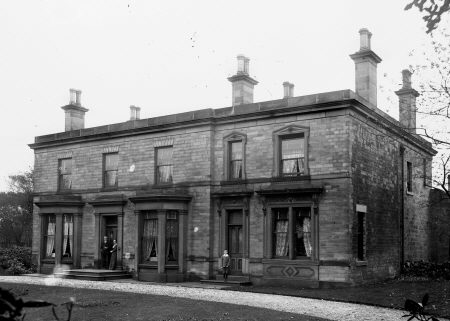
Above: Wesley House, Wesley Street pictured in about 1906. The couple stood in the left hand doorway are Edward Clay J.P. (1844-1921) and his second wife Amy (nee Blackburn). Edward Clay was the founder of the Ossett firm of Edward Clay and Sons, Mungo Manufacturers, and the first elected mayor of Ossett in 1890-91 after Ossett was incorporated as a Borough on the 16th July 1890. He was elected mayor again in 1893-94 and had served as Chairman of the Local Board of Health in 1880 and again in 1883. He was president of the Chamber of Commerce and a Guardian of the Poor, one of the first Borough Magistrates and took a prominent part in public life for many years. The boy in the right hand doorway is Edward Wilson Clay (1898-1979), their grandson.

Above: Tennis courts at the rear of Wesley House, Wesley Street about 1906. The gentleman enjoying his pipe and seated at the left of the picture is John Arthur Clay (1870-1918) and immediately to his right is his wife Annie Lois Clay (nee Wilson, 1866-1942). The boy is Edward Wilson Clay (1898-1979) with two of his Aunt Hildas. The lady with the white hat is Hilda Mary Wilson (1879-1954) and the lady on the right is also Hilda Mary Wilson (nee Pemberton, 1871-1957), the wife of Ossett artist Eli Marsden Wilson and the sister-in-law of the other two ladies in the picture.
Edward Clay was the son of Jacob Clay, who kept the Carpenter's Arms in Bank Street for many years. He started off as a hand loom weaver and later started off in business as a rag merchant and mungo manufacturer. Mr. Clay was also a partner in the old firm of Giggal and Clay, wool extractors at Healey New Mill. The business that Edward Clay started is still in existence today (2007) in Wesley Street as Edward Clay and Son, flock and mattress filling manufacturers. The business was carried on first by Edward Wilson Clay and, after his death in 1979 by his sons and grandsons.
GREEN LEA, HEALEY ROAD
"Green Lea", one of Ossett's finest houses is located down Healey Road and dates back to 1889 when construction was started by George Jessop who had bought the copyhold land, known originally as Wasscer Royd, from Charles Wheatley of Hopton, Mirfield. This "Green Lea" should not be confused with another "Green Lea" on Southdale Road, where a Miss E. Lodge had her corset business in 1915.
George Jessop was part of the of well-known Ossett firm of Messrs. Fawcett, Firth and Jessop, wool extractors, based at Calder Vale Mills (previously Gartside's Dye Works) just down the road at Healey. Sadly, George Jessop was to die in May 1891, at the early age of 53 from Russian influenza, just a few days before "Green Lea" was finally completed. Jessop's widow Martha Jessop (nee Fawcett) and their three children: two sons (Arthur and Sydney) and a daughter, continued to live at "Green Lea" after George Jessop's death. Martha Jessop was to die in 1903 and ownership of the house was passed on to son Arthur Jessop, who lived at "Green Lea" until 1918.
In 1918, Arthur Jessop sold the house to Mrs. Sarah Smith, the wife of Ossett rag merchant, Robert Dixon Smith. The Smiths lived at Denholme Drive in Ossett in 1911 and after buying "Green Lea" in 1918, stayed there until the 1930s. Robert Dixon Smith died at Ossett in April 1933, leaving just £491 to wife Sarah in his will. In 1938, the house was sold for £1,250 to Louisa Dunning, the wife of William Strickland Dunning of St. Albans, Herts.

Above: Green Lea in 2012, set in a commanding position overlooking the Calder valley. My thanks to Greg and Sue May, present owners of "Green Lea" for details of the history of the house. Photograph by Stephen Wilson.
The Dunnings only had "Green Lea" for four years and in 1942, the house was sold to William Sykes Ltd. of Horbury, sporting goods manufacturers. William Sykes Ltd. was famous in the 20th century for the manufacture of high-quality cricket bats, used by stars such as the Australian Donald Bradman. Later, Sykes merged with other sporting goods manufacturers to become Slazengers. It is not known whether William Sykes Ltd. used the house as offices or for accommodation, but in September 1948, "Green Lea" was again sold, this time to the Ossett firm of Jonas Woodhead, manufacturers of springs and shock absorbers for motor vehicles. Whether Woodheads intended to use the house for office accommodation is not clear, but they were to sell the house again in May 1949 to Mrs. Isabel Dodds.
My thanks to Greg & Sue May current owners of "Green Lea" for much of this information and permission to view and photograph their beautiful house.
WEST WELLS HOUSE
Between 1871 and 1881, West Wells House became the residence of Mr. Charles Thornes Philips, (born 4th August 1836), the son of Ossett grocer and prominent Wesleyan, William Phillips and his wife Mary. Phillips was the principal director of C.T. Phillips and Son, merino, mungo and shoddy manufacturers, with premises located at Queen Street, Wakefield Road and Whitley Spring Mill, Flushdyke. He was also interested in coal mining, and at one time financed the colliery company, which worked a small mine at Runtlings Lane.
Charles Philips was deeply involved in local public life. He was chairman of Ossett magistrates around the turn of the 19th century; the secretary of the old Mechanic's Institute in 1852; member of the old Board of Surveyors in 1865; vice chairman in 1866; chairman of the Local Board in 1872 and 1874; the first president of the Chamber of Commerce; the provisional Mayor of Ossett in 1890; a former trustee and treasurer of the White Cloth Hall in Leeds and also a West Riding Magistrate.
In 1898, Phillips vacated West Wells House and retired from business to live at Rushden Lodge, Scarborough with his daughter Clara after his wife Esther (nee Tolson) died in 1900. She was the daughter of the Mr. Thomas Tolson, carpet manufacturer, Flushdyke. Charles Phillips died at the age of 82 in December 1918 and was buried in the Wesleyan Burial Ground at South Parade. His only son, Mr. Thomas W. Phillips, an ex-mayor of Ossett, who lived at Mallin House, Ossett, died in 1915 aged 50. However, the business at Whitley Spring Mill, Flushdyke was continued after the death of the two principals.

Above: West Wells House in its heyday circa 1918. The lady on the left is Margaret Smith (nee Buckett) who purchased West Wells House in about 1914, shortly after her marriage to Ossett shoddy manufacturer Reginald Smith, who had premises on Intake Lane. Part of Smith's factory on Intake Lane can still be seen today.
The public well for the area was located to the right of the rear entrance of West Wells House, behind the pinfold. It was finally concreted over about 1950 after falling into disuse. Brook's Mill was also part of the West Wells property and there was a Gate House which was at the entrance to the old orchard, which was demolished sometime in the 1950s.
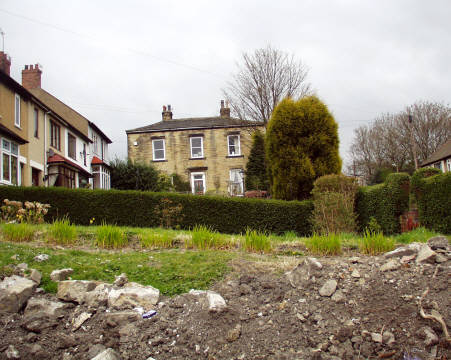
Above: West Wells House pictured in 2003. The houses on the left were built in the old grounds of the house by the then owners, the Smith family in the 1930s. My thanks to Tony Smith, Melbourne, Australia the grandson of Reg and Margaret Smith, the owners of West Wells House who left Ossett for Australia in 1951. Tony lived at West Wells House between 1946 and 1951 and has been kind enough to provide the two pictures of the house shown here. Photograph by Stephen Wilson.
ELDER HOUSE, ROUNDWOOD ROAD, TEALL STREET
Elder House was situated in extensive grounds of 1.5 hectares (3.6 acres), on Roundwood Road, off Teall Street in South Ossett, immediately to the east of The Little Bull Public House. It was probably built in the 1870s for the Bentley family who occupied the house for almost 70 years until 1939. It became the home of Thomas Wilby Bentley (1855-1926), who became Mayor of Ossett in 1909-1911, and later the home of Wynyard Lionel Rose (1913-1989), a Doctor of Pathology. Elder House was demolished in the late 1980s or the early 1990s when consent was granted, in 1988, for the development of sixteen detached dwellings to be built on the Elder House estate. This is the story of the Bentley and Rose families who lived at Elder House for almost 120 years.

Above: 1905 Map showing Elder House (highlighted in red) off Roundwood Road facing the Baptist Chapel & Burial Ground on Baptist Lane.
William Bentley, a farmer and the son of a farmer, married farmer’s daughter, Elizabeth Wilby at Wakefield St John’s Church on 27th October 1853. The marriage registration indicates that both William and Elizabeth were “of full age” although Elizabeth, from Ossett Low Common, was barely 21 years old. However, William Bentley’s origins and age are less certain but it is likely that he was born in 1826, and baptised at Ossett Green Independent Congregational Church, in the same year. In 1851, William was living on Ossett Green with his parents. His father was a molecatcher and William was an agricultural labourer. Elizabeth and William’s first child, Annie Wilby Bentley, was born on 13th November 1853, just 17 days after the couple’s marriage. Annie was baptised in South Ossett on 1st January 1854.
By 1861, the couple had three children: Annie Wilby Bentley, born November 1853; Thomas Wilby Bentley, born on 12th May 1855, baptised in South Ossett on the 14th October 1855, and Joseph William Bentley, born in Spring 1860. In 1861, Elizabeth and her three children, aged 7, 5, and 1 year-old, were living on Ossett Low Common with her 66 year old widowed mother, Grace Wilby. The record shows that Elizabeth, a dressmaker, was married but her husband, William, is not recorded in the household. The William Bentley born 1826 was living with his parents, and siblings on Albert Street and working as a farmer and gardener. William Bentley was mentioned in John Harrop’s Will in early 1865, where reference was made to William occupying one of three cottages and gardens in South Ossett. These cottages were located on Albert Street where William was living in 1861.
Elizabeth had her fourth child, Emily, born in late 1862 and Elizabeth’s mother, Grace, died in the mid 1860s. By 1871 Elizabeth, aged 39, was living on Ossett Low Common with her four children, aged between 9 and 17 years and it is possible that the family were still living at their deceased grandmother’s home on Low Common. By this time Annie was working as a burler and Thomas, aged 15 years, was a steam crane engine driver. Just as it was in 1861, there is no sign of William in the household, or elsewhere, in 1871.There are records of the deaths of two men named William Bentley, registered in Dewsbury in 1870 & 1875. One of these men was almost certainly Elizabeth’s husband.

Above: Elder House facing Baptist Lane, South Ossett photographed in 1981 about 10 years before demolition.
In Summer 1873 Elizabeth, had her fifth child, Percy John Bentley. Sadly, the infant, Percy John, died in Summer 1875, shortly before his second birthday. Elizabeth Wilby Bentley of Elder House passed away less than a year later, on 8th March 1876, aged only 44 years. It is probable that William Bentley died in the early/mid 1870’s too and the sudden deaths of two of her loved ones may have become too much for Elizabeth to bear. Mother and child were buried in the nearby Baptist Lane Burial Ground in sight of their Elder House home. It is said that in life so it is in death, and so, just as there was no obvious sign of William Bentley in the 1861 or 1871 Bentley household, he appears not to be buried in the Baptist Lane grave which is the resting place of his wife and two of his children.

Above: Headstone at Baptist Lane of Elizabeth, Percy John and one of Elizabeth’s other two sons, Joseph William Bentley.
By 1881, Thomas Wilby Bentley, Elizabeth’s elder son, assumed the role of head of household at the Bentley family’s Teall Street address. Thomas, aged 27, was by now an unemployed brewer’s clerk, his brother, Joseph William, aged 21, was a timber merchant’s clerk, his elder sister, Annie, aged 29 was a housekeeper and youngest child, Emily, aged 19, was working as a cloth inker at a wool mill. Annie married building contractor, William Henry Kershaw in Summer 1889 and moved to live on Park Square and so by 1891, and in 1901, only Thomas and Joseph, both rag merchants and latterly mungo manufacturers, and Emily the housekeeper were living at their Teall Street address.
In Summer 1908, Joseph William Bentley married Florence Mary Mellor at Wakefield and by 1911 they had a daughter, Emily Mabelle (who subsequently married Harry Westwood). The family were living on Clarendon Road, Ossett in 1911 and subsequently moved to "Grassholme" on Manor Road. Joseph died there on 20 April 1944 and probate was granted to his wife, Florence Mary and, his daughter, Emily Mabelle Elizabeth Westwood. Joseph’s effects were £8888 17s 6d.
Thomas Wilby Bentley subsequently became Ossett's mayor for two years between 1909 and 1911. His election as Mayor by his colleagues suggests that he would have held the office of Councillor of the Borough for several years prior to 1909.He is shown in the following picture at his mayoral ceremony at Ossett Town Hall, unusually without his top hat. Thomas Wilby Bentley never married, and is shown in the picture with his younger sister Emily, who was his mayoress.
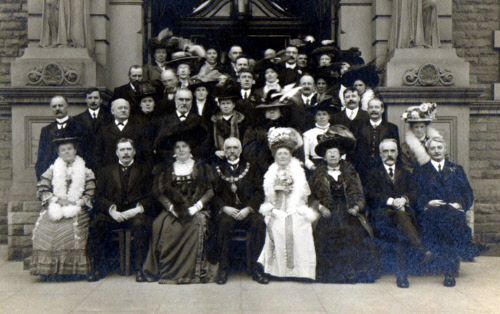
Above: Thomas Wilby Bentley in his Mayoral chains, with his spinster sister, Emily alongside.
By 1910, Thomas Wilby Bentley was the joint proprietor of Hope Mills, Ossett Spa (see http://ossett.net/ossett_mills.html) with his younger brother Joseph William Bentley. Thomas was also Chairman of Governors at Ossett Grammar School from 1905 until shortly before his death in 1925. Former OGS pupils may recall the school houses called Bentley, Pickard, Marsden and Haigh after Ossett's great and good. In 1911 only Thomas Wilby Bentley and his spinster sister, Emily, were living in the six roomed, Elder House, Teall Street, Ossett.
Thomas Wilby Bentley of Elder House, Ossett, born 12th May 1855, died on the 17th November 1926, aged 71 years. Probate was granted to his sister Emily Bentley; his brother Joseph William, merchant; Joseph Archer, secretary, and Thomas William Wilson, town clerk. His effects were £11,919 15s 2d. His spinster sister, Emily, born late 1862, continued to live at Elder House until her death, aged 77 years, on 26 June 1939. Probate was granted to William Louis Rene Wood, surgeon of Sowood House, The Green and Harry Garfield Chapman, headmaster of Ossett Grammar School. Her effects were £16,287 17s 8d. Thomas William Bentley was buried on 20th November 1926 at the nearby Baptist Lane Burial Ground. His sister, Emily Bentley, was buried in the same Burial Ground on 29th June 1939.
It appears that Emily Bentley left funds to enable the provision of accommodation for people less fortunate than herself. In October 1953 Ossett Borough Council acquired land at Teall Street for housing site and site of Emily Bentley Homes. In 2016, Emily Bentley Homes or Almshouses are located at 103 Teall Street, adjacent to The Little Bull Public House and only 200 metres or so away from the former site of her Elder House home. The Almshouses, operated by Anchor Housing Association provide unsupported amenity housing in four apartments for prospective residents who have preferably lived in the borough of Ossett for two years. A fitting tribute to the memory of a family who themselves had suffered hardship.

Above: Emily Bentley Almshouses, 103 Teall Street, on the right of the picture.
Although Emily Bentley died in 1939, quite possibly at Elder House, it was October 1953 before Ossett Borough Council acquired land for the site of the houses for which she left a bequest. It was about this time that Wynyard Lionel Rose was first recorded with a Teall Street address. Dr Rose MSC, FRCPATH, as he was known, was a Pathologist of some repute. He was born in Rotherham in 1913, married Annie Frear in the Sheffield area in late 1940 and the couple had three sons, including twins.
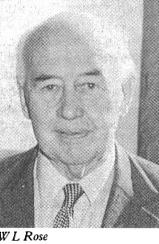 During World War II Dr Rose served in the Royal Army Medical Corps in Sudan and Italy, 1941-1946 becoming major. He was also a keen cricketer in his youth and a member of Yorkshire Cricket Club for most of his life.
During World War II Dr Rose served in the Royal Army Medical Corps in Sudan and Italy, 1941-1946 becoming major. He was also a keen cricketer in his youth and a member of Yorkshire Cricket Club for most of his life.
Dr Rose was recorded in Wakefield, Newstead Road, from about 1948 when he was appointed as consultant pathologist to the Wakefield Group of Hospitals: a position he retained until 1981. He had earlier held similar appointments at Sheffield and Wolverhampton where his twin sons were born shortly before his move to Wakefield. Shortly afterwards, in 1951, he was first recorded with a Teall Street address, namely "Sherwood Mount." It is unclear if this was another house name for Elder House. Bearing in mind the setting of the house, the name Sherwood may have seemed appropriate. Dr Rose was at the "Sherwood Mount", Teall Street address until at least 1964 and between 1968 and 1983 his address was Elder House. Sadly, his first wife, Annie, died in early 1978 and later that year he married Mavis Crowe in the Darlington/Durham area.
In October 1980 an application was made for planning consent for residential development of the 1.47 hectare Elder House site. The application was approved in July 1981 and in February 1986 consent was granted for the felling of 26 trees and the crown raising of trees adjacent to the access and dwelling at Elder House, 109 Teall Street. In April 1988 consent was granted for the erection of 16 detached dwellings with private garages on the Elder House Estate, 109 Teall Street and thereafter applications were made for the erection of individual properties with the last one recorded in October 1996.
Dr Wynyard Lionel Rose died on the 15th May 1989, aged 76 years. It is not certain how long before his death he continued to live at Elder House or the precise date when the house was demolished. It seems likely though that the demolition would be the late 1980s or early 1990s. In the mid/late 1980s Elder House gained a reputation amongst the local youngsters and their imagination got the better of them as they played in and around the 3.5 acre Roundwood Road site. The extensive, unfenced, seemingly empty, remote and heavily wooded location was a popular haunt, in more ways than one, as fiction got the better of fact. As is often the case there was truth in some of these rumours. After all, Dr Rose was a Pathologist.
We acknowledge the contributions made to the History of Elder House by the Ossett Through The Ages (OTTA) Facebook Group.
WESTFIELD HOUSE
Westfield House is located along Wesley Street, on the opposite side of the road to Wesley House, but some distance further away from Ossett town centre.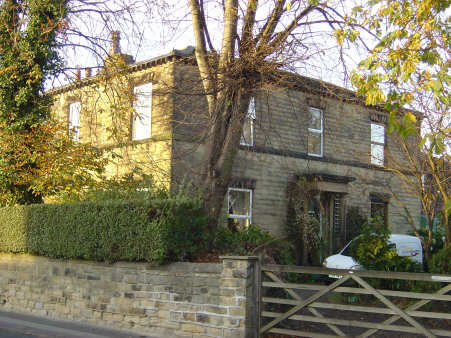
Above: Westfield House pictured in 2007 from Wesley Street
After first occupying the house shown below, which is close to Westfield House, John Westerman went on to build Westfield Mill on the opposite side of Wesley Street, and he then moved into the newly built Westfield House (above). By 1927, the house was occupied by Ossett rag merchants John W. Hewitt (b. 1866) and Herbert W. Hewitt who had premises in Wesley Street.
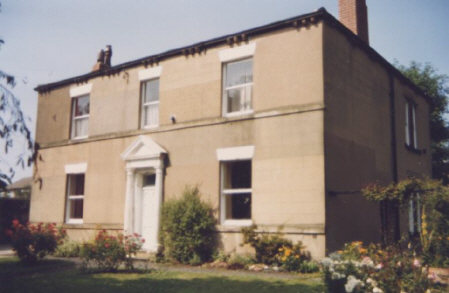
Above: This house, number 33 Wesley Street was built for John Westerman around 1850. In the 1851 census Westerman was a master clothier and rag dealer, employing 24 men and 30 women. Westerman's rag warehouse was located adjacent to this house and was demolished about 1975. The house then became the manse for the Wesleyan Methodist Chapel from about 1870 until 1971. In 1971 it was purchased by Brian Smith.
MANOR HOUSE or MANOR VILLA, off MANOR LANE
Manor House or Manor Villa1 is situated on Cave Well Gardens, just of Manor Lane. The fine-looking house was built about 1870 by Ossett mill owner, Mark Wilby (1827-1912), one of the partners of nearby Manor Mill, which has now been demolished and replaced by housing. Manor House was built on land that Mark Wilby had purchased from Nathan Mitchell who had built nearby Bleak House on Manor Road in the 1860s.
In November 18692 Nathan Mitchell, gentleman and Mark Wilby, cloth manufacturer, were parties to a conveyance whereby Mitchell sold 2 acres, 1 rood and 27 perches of land for Manor House bounded to the east by Hallas Road (later Manor Lane); to the west by land in the ownership of the Vicar of Dewsbury (Vicars’ Fields); to the north by land owned by Nathan Mitchell (on which Bleak House had been constructed in about 1864), and to the south by land in the ownership of Ebenezer Fothergill. The Deed was witnessed by Nathan’s brother Eli Mitchell, a solicitor, who lived at Little Town End, Ossett and by David Pickard, “Green Mount”, Ossett who was Mark Wilby's partner in their cloth manufacturing business at nearby Manor Mill.
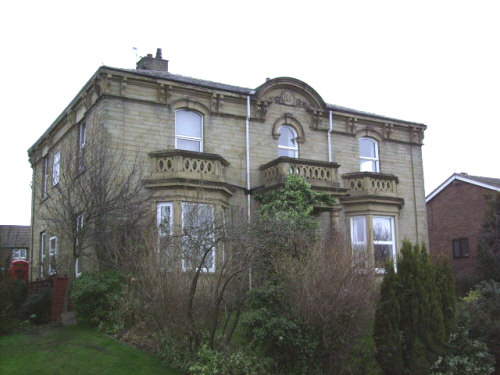
Above: Manor House or Manor Villa, which has been converted into apartments and all the original grounds sold off for new housing, which completely surround the house, which was built about 1870.
Mark Wilby was born in Ossett and christened here on the 10th June 1827. He was the son of George Wilby (1790‐1879) , Ossett woollen cloth manufacturer and his wife Jane (nee Atkinson), who were married on the 1st June 1818. Mark was the fifth child of eleven born to the Wilbys between 1818 and 1841. The first sign of Mark is in the 1841 Census at the age of 14 when he is living on Middle Common with his parents and eight of his siblings.
In 1851, Mark (24) now a woollen cloth manufacturer married Martha Clegg (born 1829) in Wakefield and they are living on Upper Common, Ossett with Martha’s widowed mother Ann Clegg(45) and her son Frank Clegg (20). Ann is a shopkeeper and Frank a woollen cloth manufacturer, employing one man. There is no sign of Mark Wilby and his family in the 1861 census.
By 1871, Mark Wilby and his wife Martha are now living for the first time at Manor Villa with six children born between 1853 and 1866. Jane Ann Wilby was born in 1853, Eliza (1856), Emily (1859), Sarah Ellen(1861), Frederick Atkinson Wilby (1863) and Kate or Catherine born in 1866.

Above: Mark Wilby made certain that future generations knew of his achievements and his initials are carved high in the ornate stonework on the front of Manor Villa.
In 1881, Mark, a woollen cloth manufacturer, employing 40 people, is still at Manor House with his wife and five children. The eldest of Mark and Martha’s children, Jane Ann Wilby married Alfred Farrar, a Woollen Manager in 1875 and had left Manor House, but in 1891 the Farrars were living next door at Bleak Cottage.
Manor House in 1891 is still home to 64 year old Mark, but his wife Martha passed away in 1886. Mark is living with one of his daughters, Eliza(35) and grand daughter Kathleen Smith, the daughter of Alfred Farrar Smith and Jane Ann Smith (nee Wilby) who are living yards away at Bleak House. He has a general servant to help out with domestic duties and Manor House is a large house for three people. There are records (an Abstract of Title for Bleak House and a Deed of 1894) which suggest Mark was in possession of Bleak House around this time. He certainly did not own Bleak House and so it seems likely that he rented the house from James Mitchell or his son Godfrey Mitchell who were the beneficiaries of Nathan Mitchell’s estate. It is probable that Mark sublet Bleak House to Alfred and Jane Ann Smith.
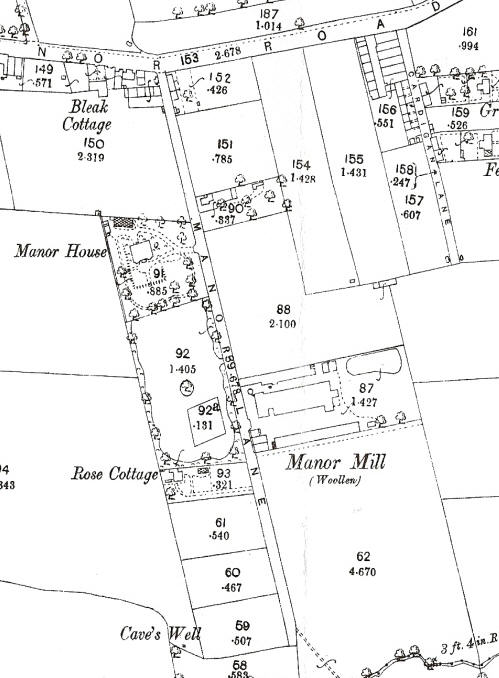
Above: Extract from an 1890 Ordnance Survey Map showing Manor House and the proximity to Manor Mill and also Bleak Cottage.
Two of Mark’s other children Frederick Atkinson Wilby and Sarah Ellen Wilby had married in 1887 and 1890 respectively. Frederick married 19 year old Ada Sophie Whiteley of Earlsheaton and they had four children between 1889 and 1895. In 1891 Frederick A. Wilby was a woollen cloth manufacturer living on Park Square and by 1901 he was an Insurance Agent living with wife Ada and their four children at Prospect House near the centre of town.
In 1890, Sarah Ellen Wilby married Thomas William Phillips. Phillips was the only son of Charles Thornes Phillips (1836-1918) of West Wells House (see above). Thomas W. Phillips served as Ossett's mayor 1908/09 , and lived with Sarah Ellen at Mallin House, Ossett. Sadly, Phillips died in 1915 aged just 50.
In 1892 Kate or Catherine Wilby (born 1866) married John William Cussons, a manufacturing chemist born in Louth, Lincolnshire in 1868. John William was the son of Thomas Tomlinson Cussons, who in the early 1880s opened Cusson's chemist shop in Station Road Ossett.

Above: Rare picture of Mark Wilby's Manor Mill from the early 1970s when it was under the ownership of Windsor & Firth Ltd. Manor Mill was first built in 1854, but was severely vandalised on the 29th March 1971 before being demolished on the 8th February 1975.
By 1901, widower Mark Wilby is now 73 years of age and is still living at Manor House. He is now a retired woollen manufacturer. Interestingly, four of his daughters, two of whom are married, are shown to be at Manor House on census night. These are Jane Ann Smith(48), Eliza Wilby(45), Emily Wilby(42) and Catherine Cussons (34). Jane Ann Phillips is a mile away at West Wells and Frederick Wilby is 300 yards away at Prospect House, Station Road. A family gathering it seems. Did Mark Wilby have something to announce? Perhaps he was about to sell Manor House? We may never know.
Mark Wilby anecdote
I'm not sure of the origin of this anecdote, but it dates back to the early part of the 19th century and concerns the aftermath of a passenger train accident that occurred at Wrenthorpe. Mark Wilby was a passenger on the train, travelling from Ossett to Leeds, when it ran into some empty coal wagons at Wrenthorpe. After the impact, the passengers in the carriage were all pushed together in a tight group when it was noticed that Mr. Wilby was bleeding from the nose and mouth. The damage had been caused by somebody or something impacting against the valuable Meerschaum pipe that he was smoking at the time. The pipe had been smashed to pieces in the collision, but Wilby was not at all concerned about his injuries, but was reportedly very upset that his favourite pipe had been destroyed in the collision. The writer of the original piece suggests that Wilby's first exclamation was "Oh, my pipe!", but somehow that doesn't ring true?
In 1905‐06 John Thomas Marsden is shown in the Ossett Burgess Roll living at Manor House, Manor Lane after Mark Wilby had moved to live in the Lancashire seaside resort of Southport where he died in 1912 aged 85. Marsden, was the managing director of Marsden Brothers, Extract Wool, Rag and Mungo Merchants, and also a director of the Woodkirk Stone and Brick Company. He had been born in Ossett in 1852, the son of Joseph Marsden and married first Hannah Nettleton (daughter of George Nettleton) in 1879 and again in 1896, Annie Glover (daughter of John Glover) after his first wife Hannah had died aged 41 in 1895.
The Inland Revenue Valuation record for 1910 shows that Manor House is still owned and occupied by John Thomas Marsden who was Ossett's mayor in 1907/08, when the new Town Hall was opened. In the garden and grounds of Manor House stands a “reservoir”, greenhouse, vinery, stable, coach house and wood shed. The Burgess Roll for 1913‐14 also shows J.T. Marsden still at Manor House. However, in 1927 Manor House is occupied by the Misses Marsden, presumably the unmarried daughters of J.T. Marsden.
References:
1. Manor House or Manor Villa notes adapted from a study by Alan Howe. Manor House pictures by Alan Howe - March 2009.
2. WYAS Deed reference of 1869, Volume 630, Page 607, No. 752.
3. Conveyance deed for the sale of William Gartside's Healey Dye Works in 1888 now held by Neville Ashby.
4. "Ossett Observer", Saturday 28th September 1912 with Mark Wilby's Obituary.
HIGHFIELD HOUSE, HORBURY ROAD
This history of Highfield House is based on a series of detailed articles by Joan P. Smith, Ossett historian, who lived there as a young girl. This article, especially for the ossett.net website, is an edited version of Joan's work, but the original article is now available as a download from the DOWNLOADS section at www.ossett.net. Joan gives us a preamble and some background to her time at Highfield:
"I always thought that there was something odd about Highfield Cottage! Why was there such a large back door? Why was there a blocked up staircase leading from the kitchen/living room to my bedroom? Why was there no proper access to the front of the house? Why did the large, built - on garage have an upper floor? Why was it built at right angles at the rear side of the ‘grander house’ (now converted into two dwellings)? These and other oddities were to puzzle me for many years.
I moved to Highfield Cottage, Horbury Rd., Ossett in early October 1946, shortly before my 10th birthday. On the morning of the removal day I was sent to Horbury Bridge School as usual with my seven year old brother George (my older sister Nellie was already attending Ossett Grammar School). After School I had to get on a bus, and bring him to our new home at South Ossett. How many 9 year-olds would be entrusted with the care of a younger sibling nowadays? We were both overwhelmed by the size of Highfield. We had spent our early years in a small two up two down terrace house on King Street, Horbury Bridge and our new home seemed like a mansion. Two very large rooms with a walk-in pantry and cellar downstairs and, three very large bedrooms and a bathroom upstairs, with hot water, a garage with an upper floor, and a garden at the front!
I have thoroughly enjoyed solving my 64 year-old puzzle and now, at last, know that my former home was a Weaving Shop! If the walls could talk I am sure they would have many interesting tales to tell."

Above: Highfield House in 2010, photograph by Joan P. Smith.
INTRODUCTION
Highfield House is located off Horbury Road in South Ossett about 100 yards to the south-east of South Ossett Parish Church. The house is approached by a long block-paved driveway off Horbury Road, located between Clarendon House and a detached house called "Montrose" that fronts the main road. The croft or field that was located beyond the gardens and to the front of Highfield House was sold some years ago for housing in the 1970s and a number of houses now front Horbury Road making it difficult to see Highfield from the road.

When first built around 1860, Highfield House would have been quite grand, as befitting the home of a successful Ossett woollen manufacturer. Since then, the stonework has suffered badly over the years due to the sun and as the result of repeated sandblasting to remove the soot and grime left by Ossett's many mill chimneys. In front of the house was a very large, lawned area, surrounded by shrubbery. At the bottom of the garden was a hedge which separated the house from the ‘croft’ or field, in which houses were eventually destined to be built.
The present owners of Highfield House, which has now been converted into two semi-detached dwellings are No 1, Lisa and Craig Hudson who bought the house in July 2007 and No 2, Elizabeth and Melvyn Speight who bought their house in December 2009. Unfortunately, Highfield Cottage is unoccupied and awaiting renovation.
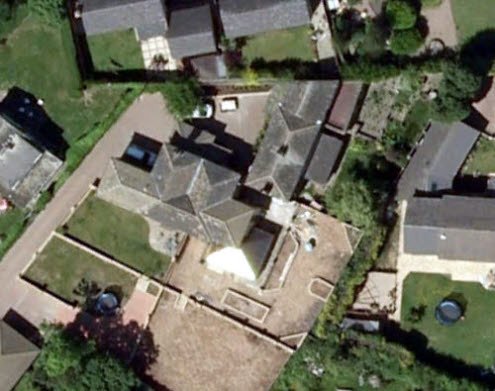
Above: Aerial view of Highfield House 2010, which shows how the house has been separated into two semi-detached dwellings, with Highfield Cottage at right-angles to the north.
THE LAND AWARDED TO JOHN CRAVEN
Highfield House was built by Ossett clothier John Harrop (1800-1865) circa 1860 on a one-acre site to the eastern side of Horbury Road and was originally where Harrop ran his home-based weaving business. The one acre and 25 perches of land that Highfield House was built on was first awarded to John Craven in the Inclosure Act, 1807-1813.
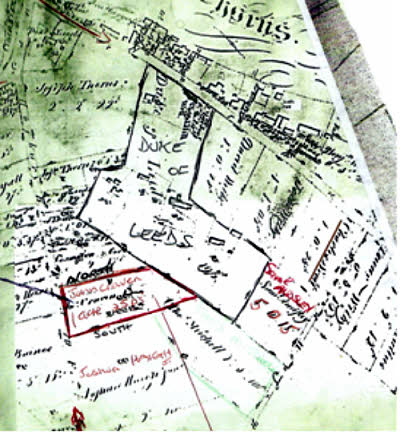
Above: Inclosure Award Map showing the 1 acre site awarded to John Craven. There were no buildings on the land when it was awarded to Craven.
The one acre of land awarded to Craven was unusual in that 25% was freehold, 25% was copyhold and the remaining 50% was classed as "freehold and copyhold undistinguished". Most likely, there were parts of land in this half-acre section that were definitely freehold and other parts that were definitely copyhold, but the boundaries would be unclear. It was therefore impossible to distinguish with confidence which piece of land was freehold and which was copyhold, hence the term copyhold and freehold (but) undistinguished.
The next reliable source of information about the land was the Ossett Tithe Award of 1843 when the owner of the plot is now recorded as William Lee, who was by now sub-letting the 1 acre and 25 perch site (as before) to William Mitchell junior. There were still no buildings on the site in 1843. William Lee was the grandson of the late John Craven who had probably died in 1837 and he was the son of Craven's daughter Ann, who had married John Lee on the 24th July 1796 at Horbury St. Peter's Church. William Lee had been baptised on the 19th September 1802 and later married Ann Swann at Snaith in 1825.
The land was sold to Joseph Marsden, of Storr's Hill, Ossett by a deed of conveyance on the 29th November 1850, signed by William Lee, yeoman of Horbury and his two unmarried daughters, Jane Ann Craven Lee (c. 1830) and Adelaide Craven Lee (c. 1833) who were his only surviving children. William Lee's only son, John Craven Lee had died aged 19 years in 1847.

Above: 1854 Ordnance Survey Map showing the plot of land that Highfield House was built on.
The land was again sold by deed of conveyance on October 27th 1854 by Joseph Marsden, designated now as a skinner (fellmonger), still of Storr's Hill, Ossett to John Harrop, woollen manufacturer of Ossett Common. Also mentioned in the deed is Nathan Mitchell, farmer of Ossett Common. Mitchell owned a plot of land immediately adjacent to the plot being sold to Harrop and it is likely therefore that he was farming this land as well as his own. By now, a mistal (a building where cows are milked and kept) had been erected on the land so it seems likely that Nathan Mitchell was dairy farming on the two adjacent plots. It is also possible that Joseph Marsden in his role as a fellmonger may have bought any dead cattle to utilise the skins for the leather trade. In the event, Joseph Marsden died in 1860, aged 50 years, but it is likely that Nathan Mitchell continued to rent the land from new owner John Harrop to carry on his dairy farming enterprise.
JOHN HARROP
John Harrop (or Harrap) who built Highfield House was christened on the 28th March 1796, one of at least ten children of Ossett clothier Joseph Harrap and his wife Mary (Butterfield). John married local girl Martha Illingworth on Christmas Day 1818 in Dewsbury and they went on to have at least nine children: William born 1820, Abraham born 1822, Mary born 1824, Isaac born 1826, Jacob born 1829, Robert born 1832, Martha born 1834, John born 1837 and Mark Harrop born 1841.

John Harrop's address on the 1861 Census was listed as Horbury Road and it is very likely that this will have been Highfield House. He made a Will on the 23rd August 1862 and in this he describes his homestead at South Ossett as consisting of a "Messuage or Dwellinghouse, Shop, Stable, Outbuildings and Appurtenances", suggesting that Highfield House and the associated buildings were erected between 1854 and 1862. John Harrop died on 6th Jan 1865 and his Will was proved on the 9th March 1865. In Harrop's Will, which was an extensive document spread over five A3 pages, he makes the following provisions:
"I give and bequeath all that my homestead at South Ossett, consisting of a messuage or dwellinghouse, shop, stable, outbuildings and appurtenances thereto belonging together with the croft or close of land thereto adjoining, and all those my five shares in Healey New Mill and all lands, hereditaments etc. belonging to the said Mill and all that one other stand in the Cloth Hall at Leeds, together with all the residue of my real estate, goods etc. unto my friends George Illingworth and George Harrop, both of Ossett aforesaid, manufacturers and my said sons Abraham and Isaac Harrop, their heirs executors etc., hereinafter called my trustees and shall as soon as conveniently may be after my decease will collect in and receive all the real and personal estate etc.. and to dispose as they see fit and after all expenses have been deducted to give the following sums of money to my son Mark Harrop two hundred and fifty pounds, my son John Harrop two hundred and fifty pounds, my son Isaac Harrop one hundred pounds, my son Jacob Harrop fifty pounds, my son Robert fifty pounds. The residue of the estate after all expenses has been paid, if any, to be divided between my said sons and daughters."
He also left several cottages in the Horbury Road area to his children, in which his sons and daughter were already living. The exceptions were John and Mark Harrop, who were still living at Highfield. The Will at first reading suggests that John Harrop left the majority of his estate to his two "friends" George Illingworth and George Harrop. It is Joan Smith's view that George Illingworth was John Harrop's brother-in-law (the younger brother of his wife Martha) and that George Harrop was his younger brother (b. 1813) who lived at Rock House and was the principal of the Albion Mills enterprise at Horbury Bridge. Harrop and Illingworth were in fact the executors of John Harrop's Will and not beneficiaries as such. John Harrop had a large family and the Will contained numerous individual bequests to his children. It would have been necessary for his executors to make absolutely sure that his wishes were carried out properly. Why the solicitor named the two executors as "friends" is still not clear.
In the event, Highfield House was offered for sale in the "Leeds Mercury" on Saturday, 18th March 1865 at an auction to be held at the Cooper's Arms Inn, Ossett. The advertisement is reproduced below:

It isn't clear if Highfield House was sold in March 1865, but it seems more likely that the house was rented out. All of John Harrop's sons were cloth weavers and therefore it is likely that they made full use of the weaving shop at Highfield. Another scenario is that Harrop's two youngest sons, John and Mark Harrop lived at the house.
In a memorializing deed dated 9th December 1873, in which probate of John Harrop's Will was granted to his son Isaac Harrop (one of the devisees), the homestead at South Ossett was described again as consisting of a "Messuage or Dwellinghouse, Shop, Stable, Outbuildings & Appurtenances thereto belonging together with the Croft or Close of land thereto adjoining & all those Testator's 5 shares in the Healey New Mill in the Town of Ossett and all the lands, hereditaments & premises and other real estate belonging to the said Healey Mill Co., & rights, members, privilege & appurtenances respectively belonging with the residue of his (Testators) real estate (if any). (Ref: Vol 696/696/825)"
SAMUEL PICKARD
Not long afterwards, in a Deed of Conveyance dated January 8th 1874, Highfield House, together with the weaving shop, burling house, stable and other outbuildings plus the allotment or close of land extending to approximately one acre and twenty-five perches was sold to Samuel Pickard, Ossett gentleman and retired manufacturer. Samuel was the son of weaver Robert Pickard and was born circa 1813, most probably at the home of his parents at 9, Haggs Hill Road, Ossett. He was still living at Haggs Hill in 1841 when he was working as a journeyman clothier. In common with some of his Ossett Pickard cousins, he was determined to do better for himself and by 1861, he had moved to Giggal Hill where he was living with his wife and two children, most probably in one of the cottage properties in Scott's Yard. The same conditions applied to the Highfield land in respect of copyhold, freehold and "freehold and copyhold undistinguished" that had been the case at the time of John Craven acquiring the land between 1807 and 1813.
In the 1871 census, clothier Samuel Pickard, with his wife Jane (Wilby), and their son Alfred Hinchcliffe Pickard (also a clothier) with wife Mary Harriett (Hemingway) and their children Samuel Norman and Arthur Vincent are all living on Church Lane, South Ossett in one dwelling. In addition, living with his grandparents is John William Pickard, the illegitimate son of Emma Pickard who sadly died in 1863 a few months after the birth of her son. There are two census schedules for one dwelling, so it is possible that they are already renting Highfield House in 1871. Church Lane was also known as School Lane and eventually became Vicar Lane.
In the 1881 census Alfred Hinchliffe Pickard is now retired at the early age of 36, and is living with wife Mary Harriett and their children Samuel Norman, aged 12; Arthur, aged 10; Charles Bernard aged 8 and Edith Mary aged 1 on Horbury Road, not far from South Ossett Church (most probably at Highfield House) with Mary Harriett’s sister Lucy Spink. Samuel Pickard, who is now retired, is living with his wife Jane and grandson John William, (now an articled clerk) all at Sowood House on Sowood Lane.
Shortly before Samuel Pickard died on August 26th 1883, he passed the property on Sowood Lane (Sowood House) over to his grandson, John William Pickard, (mentioning the ‘lately erected dwelling’). In his Will, Samuel Pickard bequeathed to his son Alfred Hinchliffe Pickard "All that dwellinghouse now already occupied by Alfred situate at Horbury Lane, South Ossett together with the three cottages, mistal and a close of land adjoining the same," which we assume to be Highfield House. Horbury Lane later became Manor Rd., and the entrance to the property would originally have been from there. An entrance on Horbury Road must have been made later. Samuel Pickard also left his son Alfred "fourteen cottages situate at Richmond Hill, Leeds also the six cottages situate at Westgate Common, Wakefield, also six cottages situate at Park Square Ossett Common aforesaid, all with their respective appurtenances." Samuel Pickard was clearly a wealthy man, also leaving shares in many local companies including the Wakefield Gas Light Company the Mirfield Gas Light Company, the Barnsley Gas Light Company and Healey Low Mill. He had also loaned money to Dewsbury and Batley Corporations in the form of mortgages. Samuel Pickard also owned stands at Leeds Cloth Hall, purchasing one in 1854 and a second from William Dews in 1877, a sign of his wealth and standing.
On the 1891 Census John William Pickard with Jane, his grandmother, are both listed as living at Sowood House, but John William is now "living on his own means at the early age of 28." In 1891, Alfred Hinchliffe Pickard, aged 46 and retired is still at Horbury Road, Ossett with his wife Mary and children Samuel N., (Chemist & Druggist) Arthur Vincent (Dentist’s Apprentice), Charles Bernard (Draper’s Apprentice) and younger children Emma 8 and Kate H. 6, both scholars.
In 1901 The House is actually named as Highfield House, Horbury Rd., Alfred H is a widower aged 56, living on own means, with Emma J. 18 and Kate H. 16. Samuel Norman is now married and Alfred’s other two sons are both deceased.
The Ossett Valuation Records of 1910 show Alfred H. Pickard owning a house and land, including a mistal (Highfield House) plus another house close by (Highfield Cottage), which is occupied by Chas. Priestley (and previously occupied by Harry A. Cox before 1907). Highfield House remained as a single dwelling until sometime after 1912 when Alfred Hinchcliffe Pickard died. Highfield cottage was always a separate dwelling after conversion from a weaving or burling shop as can be seen from the occupation by Harry A Cox (1907) and Chas. Priestley (1910).
In 1911 Alfred, Emma and Kate (both still single) are all still living in Highfield House. Kate Pickard later married William H. Clegg in the September quarter of 1915. They had a daughter, Dorothy P. Clegg who was born in the September quarter of 1916.
Alfred Hinchliffe Pickard died on January 18th 1912 and in his Will dated 1907, the Highfield Properties passed to his unmarried daughters Emma Jane and Kate Hemingway Pickard, with other property and legacies inherited by Ossett chemist Samuel Norman Pickard.

COPYHOLD COMPENSATION AGREEMENT - 1938
The question of what was regarded as copyhold land and freehold land on the site of Highfield was to come back and haunt the Pickard family. Since the land on which Highfield was built was part copyhold and part freehold, any transactions involving land/property of a copyhold nature had to have the consent of the Lord of the Manor.
On December 1st 1938, a Compensation Agreement was made between The Manor of Wakefield, Emma Jane Pickard and Kate Hemingway Pickard. Re. the extinguishment of a 'manorial incident' (regarding the copyhold part of the plot). The sum of £8 9s 5d was paid to the Manor by the Pickard sisters, prior to the sale of the property, which is described as 1A 25 perches (with all the usual details of the Allotment of The Inclosure Act in 1813). In 1925, the ancient copyhold nature of land holdings was abolished. However, on the first sale of land, which had previously been copyhold, the deeds could only be 'franked' after compensation was paid to the Lord of the Manor, ostensibly in lieu of rents which would have continued to have been paid had the copyhold not been abolished.
Also, details of how the properties at Highfield had been sub-divided into three separate houses:
- The Messuage or dwellinghouse known as "Highfield House" (now converted to two dwelling houses) occupied by Mr. Greaves and Mrs. Lord.
- The Weaving Shop, formerly two cottages, but now converted into one dwellinghouse known as "Highfield Cottage", occupied by Mr. Wycherley, with the burling house (now used as a coalhouse), stable and other buildings erected upon the said allotment or close of land and or on some part together with the appurtenances. (Ref: Vol 174/979/325)
In a conveyance dated Jan 20th 1939, Emma Jane Pickard (Spinster) and Kate Hemingway Clegg (widow, formerly Pickard) both of 86, Thornes Road, Wakefield sold the Highfield properties to Horace Benn of Regent Street, Horbury, Colliery Deputy (Ref: Vol 10/447/153 - same details of the Plot as Ref: Vol 174/979/325)
GEORGE AND NELLIE WORTH
In 1946, the tenancy of Highfield Cottage was taken on by Joan's parents George and Nellie Worth, who bought the property in 1964 from Annie Benn, widow of Horace. Highfield Cottage was later referred to as 3, Highfield House.

Above: Rear of Highfield Cottage showing the back door circa 1962.

Above: Corner of Front Garden, with Greystones House on Vicar Lane in background, pre 1969. Greystones House, on Vicar Lane was built by William Dews, a co-partner of Samuel Pickard.
In a later conveyance dated Aug 14th 1964 Annie Benn, the widow of Horace sells No. 1 Highfield House to Phyllis Mary Hopkins and No. 2 Highfield House to Sydney and Emmeline Turkington and No. 3 Highfield Cottage to George and Nellie Worth.
On 12th Nov 1969 (signed 5th November) (exactly 21 years since Joan's sister Margaret Worth was born there), Highfield Cottage was sold by George and Nellie Worth to Douglas John Lindsay, a Merchant Navy captain and Audrey Elizabeth his wife. (Ref: 282 772 366)
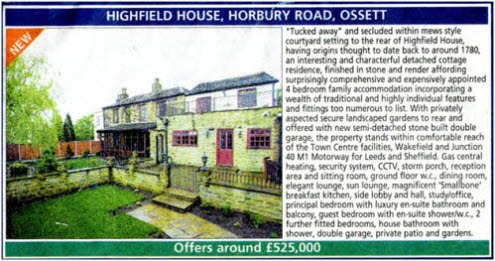
Above: Highfield House (Highfield Cottage) Estate Agent's advertisement post 2000.
SOWOOD HOUSE, SOWOOD LANE
Another of Ossett's fine houses is Sowood House, which is tucked away behind high hedges off Sowood Lane, just below the Manor Road junction. It is thought that Sowood House was built circa 1875 by Ossett cloth manufacturer Samuel Pickard.2

Above: Sowood House in 1958.
The Land:
The majority of the land that Sowood House was built on was originally bought by William Gartside, Ossett clothier (and later dyer) from Nathan Mitchell, Ossett clothier, by deed, on June 30th 1854:
All that messuage or dwellinghouse with outbuildings, foldstead garden, conveniences adjoining & therewith occupied by the said Nathan Mitchell and also all that allotment or parcel of land adjoining and there situate being on Ossett Common, near Giggal Hill and containing altogether with the site of the said messuage or dwellinghouse & outbuildings 1 acre and 8 perches approximately.
On March 10th 1864, Samuel Pickard bought the 1 acre and 8 perch 1 plot of land from William Gartside, plus 2 roods 1 and 8 perches of land to the north side of the original plot (marked 476 on the map below) from Nathan Mitchell and another 850 square yards to the west of the main plot, also now owned by Nathan Mitchell.
The total size of the plot for Pickard's Sowood House was now close to 2 acres. By comparison, a 1.1 acre plot of land for sale with planning permission for six houses on a site just 400 yards further down Sowood Lane is on the market for £1.1M in early 2011.
By 1881, Samuel Pickard, his wife Jane and their grandson John William Pickard are living at Sowood House. In a deed of conveyance signed by Samuel Pickard two days before he died on the 26th October 1883, Sowood House and grounds of 1 Acre, 2 Roods and 32 perches, 9 yards are transferred to the ownership of his grandson John William Pickard together with some more land at Armley and Wortley in Leeds.

Above: Extent of the near 2 acre plot purchased by Samuel Pickard for Sowood House in 1864.
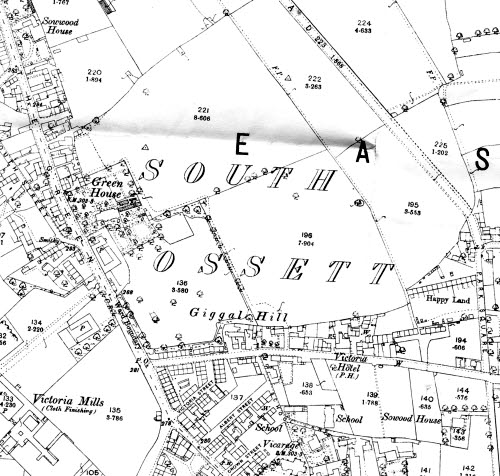
Above: 1890 map showing the location of Sowood House (bottom right) not to be confused with Sow Wood House (top left) located on Ossett Green and originally home to the Greenwood family of medical practitioners and later in the 1940s and 1950s, the location of Doctor Stoker's surgery.
The Occupants:
By 1891, Samuel Pickard's property and land is now divided up between his son Alfred Hinchliffe Pickard who was occupying Highfield House and his grandson John William Pickard, who was at Sowood House with his wife Lois and Grandmother Jane. The address is shown in the 1891 census as School Lane, (later to be known as Vicar Lane), which at this time was where the access to Sowood House would have been before Sowood Lane was built. A new entrance on to Sowood Lane must have been created sometime before 1898. Jane Pickard died on 11th October 1898 at Sowood House.
The 1901 census shows John William Pickard with his wife Lois, relatives and servant in Sowood House, Sowood Lane. On the 1911 census, John William states his address as Sowood Villa, whereas the Enumerator lists it as Sowood House.
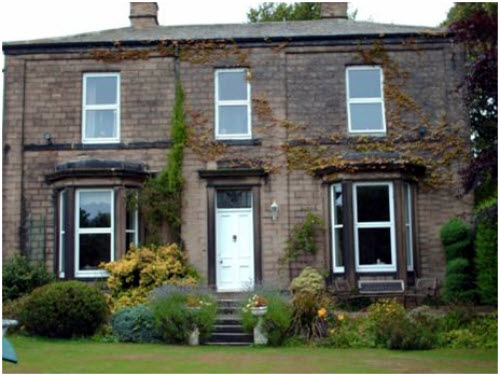
Above: Sowood House in 2010.
John William Pickard died on the 17th June 1917 aged 54. His Will was proved on the 12th March 1918:
"I devise and bequeath all the real estate to which I shall be entitled at my decease unto my wife Lois Pickard absolutely but as to estates (if any) vested in me upon trust or by way of mortgage subject to the equities affecting the same respectively and I appoint my said wife Lois Pickard and her brother Charles Brook Executors of this my Will, hereby revoking all my other testamentary writings. (Will signed 16th November 1891)."

Above: Coach House at Sowood House 2010.
Sowood House or Villa with associated land was sold to Ossett rag and mungo merchant, Harry Anelay Cox in a Deed of Conveyance dated April 7th 1925 by Lois Pickard, the widow of the late John William Pickard.
"Firstly all that close of land fronting onto Manor Rd., Ossett aforesaid containing by Ordnance Survey 2 roods 22 perches or thereabouts, bounded on the north by Manor Road
Secondly all that close of land & garden with dwellinghouse, known as Sowood Villa, outbuildings & conveniences erected on the said close of land or on some part thereof fronting to Sowood Lane, Ossett aforesaid containing by Ordnance Survey 1 acre 2 roods & 6 perches or thereabouts.
Thirdly all that plot, parcel of freehold land situate at Giggal Hill in Ossett aforesaid containing by the recent Ordnance Survey 2 roods 21 perches & 6 yards thereabout & bounded northwards by Manor Road.
Fourthly land containing 1 acre 2 roods 30 perches 9 yards bounded east by the occupation road from Ossett to Horbury, west by premises therein before thirdly described."
John William Pickard and his wife Lois did not have any children. Between July and September 1932, Lois Pickard died aged 72. Her death was registered in the District of St. Thomas in the Exmouth area of Devon and it would appear that she had moved away from Ossett sometime after 1925, unless she was on holiday in Devon at the time of her death.
Harry Anelay Cox (1870 – 1942)
Harry Anelay Cox was born in Bradford in 1872, the 10th child of Joseph Cox and Sarah Anelay. He married Olive Moys, daughter of William Moys and his wife Emma between January and March 1901. On the 1891 Census William Moys, aged 45 is listed as a Gas Works Manager, born in Canterbury, Kent. Emma, and the children Olive aged 15 and Herbert aged 13, were all born in Wakefield. In 1907, according to Alfred Hinchliffe Pickard’s Will. Harry Anelay Cox is the tenant of Highfield Cottage. The 1911 Census show Harry as a Rag Merchant, employer.
On 20th August 1925, Cox is in partnership with Henry Howden Dalley with Rag Warehouses in Dewsbury, in the region of Bond St., Croft St., and near the Carlton Club Building. Three months later the business is changed to Firth, Dalley & Cox Ltd. whose registered Office is situated in Wellington St., Dewsbury. Harry Anelay Cox is a Director of the Company.
On April 26th 1938 Mildred Cox, daughter of Harry and Olive died at Sowood Villa, aged 31. Four years later Harry Anelay Cox died on May 23rd 1942 aged 70 years and six months later his widow Olive died on Nov 26th aged 67 years.
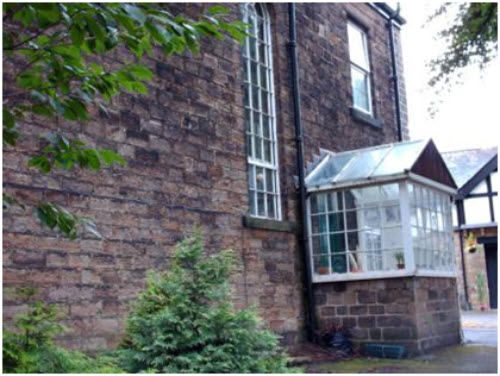
Above: Rear of Sowood House 2010.
In his Will dated 8th February 1933 Harry Anelay Cox, appointed his wife Olive and his sons (the vendors) and Harold Cox to be the Executors of the Will, which had been proved on 8th July 1942.
In a Deed of Conveyance dated March 30th 1943, Charles Herbert Cox of Sowood Villa Ossett, Rag Merchant sold Sowood Villa and land to James Ellis Walker of ‘Hadley’ Benton Hill, Horbury, Yarn Spinner at a price of £1,300.
"Firstly all that close of land fronting onto Manor Road in Ossett aforesaid containing by Ordnance Survey, 2 roods, 22 perches or thereabouts bounded on the North by Manor Road.
Secondly all that close of land and garden with dwellinghouse, known as Sowood Villa, garage, outbuildings & conveniences erected on the said close of land or on some part thereof fronting to Sowood Lane, Ossett aforesaid containing by Ordnance Survey, 1 acre 2 roods & 6 perches or thereabouts."
In a deed of conveyance dated February 19th 1946, James Ellis Walker of ‘Hadley', Benton Hill, Horbury sold Sowood Villa to John Fisher Atkinson, 66 Alexander Crescent, Birkdale Rd., Dewsbury, Engineer for £2,200. Sowood Villa had not been occupied by Walker and it appears that it was rented to a Mr. Jessop and a Mr Axford (maybe of Ossett Grammar School fame?)

Above: Driveway to Sowood House off Sowood Lane. On each of the stone pillars, the name "Southwood" is carved, probably by later owners since the house was originally called Sowood House or Sowood Villa. Originally, access to the house was via Vicar Lane.
The property and land stayed in the possession of John Atkinson until it was again sold for a price of £3,400 on the 1st May 1962 in a Conveyance between John Fisher Atkinson, of Sowood Villa, Ossett, Dairy Roundsman, the Vendor and James Gordon Oakes, Company Director & Patricia Oakes, his wife, both of ‘Lyndeane’, Station Rd., Ossett, the Purchasers.
"All that plot of land at Sowood Lane, 4,430 sq yards, bounded North by property of Leslie Raymond Ross, engineer and Boovan Ross and in other part by property of Alice Jane Senior, on or towards the East by Sowood Lane and South side thereof in part by property of Harry and Sheila Tolson and in the other part by property of Frank Burdekin, West side thereof in part by property of Mayor and Borough of Ossett and in other part by the said Frank Burdekin and also all that dwellinghouse with garage, stables & outbuildings thereto belonging erected on some part of the said plot known as Sowood Villa, of which the said property is more particularly delineated on the plan annexed hereto coloured pink and edged in red and forms part of the property first and secondly described in the conveyance dated 19th Feb 1946 between James Ellis Walker of the First Part and the Vendor of the Other Part, together with all rights, appurtenances, hereditaments etc. with the exception of coal & mineral rights etc., mentioned on 19th Feb 1946."

Above: Aerial picture of Sowood House, showing stables top left and the house with grounds off Sowood Lane, just south of the Manor Road junction.
In 1985 James Gordon Oakes & Patricia Oakes sold the property to Thomas and Gina White, who are still the owners in November 2010. The House is now known as ‘Southwood’. These words are carved on the gateposts on either side of the entrance. In earlier times this whole area of South Ossett was known as the ‘South Wood’.
For more information on Sowood House, please refer to the DOWNLOADS section of this website for the work of Joan P. Smith and her "South Ossett Triangle" featuring some of the historic houses of the district.
References:
1. One rood = ¼ of an acre and a (square) perch = 30¼ square yards.
2. This article is based entirely on a more detailed paper provided by Ossett Historian, Joan Patricia Smith and has been edited to fit the www.ossett.net webpage.
STORRS HILL INFECTIOUS DISEASES HOSPITAL
The history of the hospital and the conversion to housing
By Neville Ashby
Smallpox is an infectious disease with a comparatively high mortality rate. Outbreaks were not uncommon throughout the 19th century, and the danger was ever present. In 1881, the Medical Officer for the Board of Health in Ossett, J. W. Greenwood, stated that there had recently been a serious outbreak of smallpox in the town, nearly all the cases being traceable to one source. At this time infectious disease patients were sent to the workhouse hospital at Staincliffe, Dewsbury. He said that steps would be taken if necessary to erect a temporary hospital to deal with the cases in isolation.
Prices had already been obtained from a London maker for a temporary hospital building made of iron, along with tracings of the building, which would accommodate about 20 patients. This building would measure 52 feet by 21 feet and cost £300. A plan for a wooden version of the hospital was also received, measuring 99 feet by 21 feet, and the cost of this would be £170, but this only included the outside boarding. The iron building would be lined inside with wood and the gap between iron and wood would be filled with felt for insulation. Mr Greenwood was very much in favour of the iron building. While the Chairman of the Board had been in London previously, he had seen several of these iron structures for himself and was obviously impressed with them. He made a decision to return to the city to have a closer inspection of one of these buildings. However, on his way to the railway station he called to pick up his letters, and one was from the London manufacturer. It was an offer of a second-hand structure, which had been in use for three years as a church or chapel. This particular one measured 80 feet by 38 feet, and the maker also offered to erect this in Ossett for a total price of £325 inclusive.
This building was visited by the members of the Board, and after a long consultation they agreed to purchase it for Ossett at a cost of £315. This would include erection and the inclusion of two interior wooden partitions, also for any additional windows or doors and the cleaning or making good of any damage. The members of the Ossett Health Board had negotiated well.
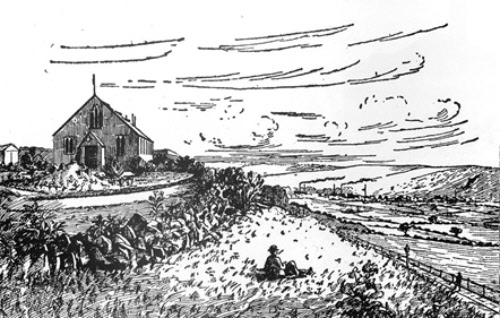
Above: Sketch from "Cockburn's Ossett", showing the first Isolation Hospital that was made in iron.
On Sunday, November 27th 1881 they met to arrange a site for the hospital, since it would be necessary to act at once in laying foundations for the building. It was agreed to place the building in the grounds adjoining cottages at Storrs Hill that belonged to the town. Previous to this decision they had considered putting it in the quarry at Storrs Hill, which was a lot less developed then. They had also tried unsuccessfully to rent land between Lodge Hill and Alverthorpe.

Above: The location of the original iron Isolation Hospital.
By the end of December that year the erection was slowly progressing. A considerable portion of the roofing girders etc. had been put up, but shortly before noon one morning high winds blew the part completed structure over, dragging with it one side of the building, the workers beneath having a narrow escape. However, work progressed and by the end of January 1882, the new hospital was just about complete. On the weekend of the 4th and 5th of February the hospital was opened for inspection by the ratepayers of the town. Between four and five thousand visitors were estimated to have looked around. The hospital was described in the “Ossett Observer” as such:
"The entrance at one end leads into a spacious and lofty passage running about two thirds of the length of the whole building. On the right hand side of this are:- a room for cooking (with gas apparatus, sink, cupboards etc.), nurses room, convalescence room and dispensary. On the other side of the passage is a large ward for female patients with a bathroom adjoining (furnished with a gas-heated bath), and at the end of the building is another large ward for male patients. A dozen beds are provided, but there is space for more than double this number if required. The whole of the rooms are well lighted, and there is abundant provision for ventilation. In the centre of the building the roof is about 26 feet from the floor. There are several stoves for warming purposes, and the place is fitted up with gas, water etc."
On Tuesday 7th February, two days after the town had inspected the building, there were five fresh cases of smallpox, and four of them were removed to the hospital the same evening. Two or three others joined them during the week. There had been some objection to the siting of the hospital, mainly because it was thought by some that its position might interfere with the numbers of people who visited the locality for the extensive views over the valley. However, it was a practical site, being away from the majority of the population of the town - an important consideration when treating highly infectious diseases. The following year it was decided to erect a stone fence wall around the building, no doubt to keep away those who had no business there and possibly to minimise the risk of spreading the disease. Later in the year a caretaker, Mrs Wilkinson was engaged to work at the hospital at six shillings per week. In December that year gales one night did much damage, the wind loosening the roof at one end and stripping off a quantity of iron etc.
On 6th July 1885 it was resolved by the Local Board at their meeting to make the cottages at Storrs Hill habitable, for the caretaker to take residence there. Four members of the Board had visited the one storey cottages and found they were in a shocking condition, with no windows or doors. The hospital was often without inmates, and it was felt important enough for the caretaker to live nearby to keep the building fit for use when required. One Board member thought that since there was little probability of the quarry being worked again in the foreseeable future, the whole of the property might be enclosed and made into a nice resort for times when the hospital was empty. He said he would like to see the low side next to the Horbury Bridge road (present day Storrs Hill Road) planted and laid out. The motion was carried.
In September a new caretaker was chosen, Mr Shaw of Gawthorpe (who had lost one arm) and his wife were selected. The appointment was made with a salary of £20 per annum, with house, water rates, coal and gas provided. When the hospital was occupied the salary would increase by ten shillings per week, with food provided. Mr and Mrs Shaw were required to keep the premises clean and ready for use. Mrs Shaw was to act as nurse when required, and her husband to then give his whole time. The engagement was subject to one month's notice. In December the Board decided to put up six lamp pillars in Storrs Hill Road, and fit them with oil lamps. It was the caretaker's job to light these in the winter.
In February 1886, a motion was carried at Ossett’s Local Board meeting that a gate should be provided for the hospital. There had been a suggestion that the bath at the hospital might be made available for the public to use when the hospital was empty for a small charge. The bath was in a room by itself. Mr Fothergill, to whom the ratepayers had made the suggestion, commented that the charge should be 3d, with 2d going to the caretaker and 1d to the Board. However, Mr Hanson suggested the charge should be 2d, which ought to go to the caretaker for his trouble. This motion was carried, and Mr Townend humorously remarked that the question of public baths for Ossett was now resolved! However, two weeks later it was mentioned that only one person wanted to use the bath. At this same meeting it was resolved to purchase shrubs and trees to the value of £5 for planting in the grounds. By July there were seats in the hospital grounds, and many people were using the place.
On April 30th 1887 it was reported that the hospital had been free of patients for two years now. However, nothing could be taken for granted, and fourteen months later an informal report made to the Local Board suggested that nearly all of the inmates at the hospital were expected to be discharged as cured within two or three days, indicating that there had been another outbreak of smallpox.
By May 1889, the hospital was reported to be "in its usual empty condition" and some portions of the building were showing the strains of the force of the winter storms, due to its elevated position. The following month, at the Local Board meeting, Mr Eli Townend suggested that maybe it was time to consider a more permanent structure in stone for the hospital. He believed that now would be a good time to build, while the hospital was empty, so that it would be ready in time to receive new cases. He believed that there was sufficient room to leave the building up until the new one was ready. Mr Cox commented that no doubt a permanent structure would have been erected originally, but it was put up when they had a serious outbreak of smallpox, and they did the best they could at the time. Mr G. H. Wilson made a suggestion that the present iron structure could be encased in brick, and an iron roof put on - this would be about a tenth of the cost of a new building. At a later meeting it was mentioned that there were between sixty and eighty "drops" from the roof during rainy weather. The ironwork was corroding. It was moved that they consider the propriety of erecting a new hospital building.
The Local Board seem to have sat on the idea, for it was a year later that Mr Townend proposed that plans and an estimate be obtained for the building of a new hospital at Storrs Hill. Still the idea was not carried forward, and nearly two years on, in March 1892, Mr Townend again proposed a motion to build a new hospital made of stone or brick. The motion was carried by 8 votes to 7. Ossett Local Board had now been superseded by Ossett Town Council following the raising of Ossett's status to "Borough" in 1890. Later in the same year there was a stark reminder of the dangers of disease when the mayor, Mr Oliver Nettleton, died of typhoid.
With the prospect of a new permanent hospital being erected, Horbury Local Board began to show some interest in sharing the cost erecting and running the hospital. Terms were agreed between the two Boards, with an agreement that Horbury contributed one third of the annual cost, wherever the patients came from. However, this never came to fruition and Horbury did not become involved. They built their own isolation hospital at Addingford, constructed from corrugated iron sheeting over timber. It had two wards and 26 beds. It was sold in the late 1940s when Horbury Urban District Council had problems staffing it.
At the end of 1892, a boy who was 6 years old died of smallpox when he was at the Ossett hospital. His mother was admitted suffering the same a short time later, and also a man named Shaw from Greatfield. Mr and Mrs Godley, the hospital keepers at that time, stayed up all night to comfort the two. Next morning at 6:40am Mr Godley asked Mr Shaw what he would like for his breakfast and left him alone.
Sadly, Mr Shaw left the hospital and ran out in front of a train at the foot of Storrs Hill. His body was conveyed to the Railway Hotel at Horbury Bridge. One of the people searching for him entered the hotel and identified him. When he said he had been a smallpox patient a number of people made a speedy exit!
A year on from Mr Townend's latest successful motion the board purchased more than two acres of land on the east side of the present structure. In April 1893 local architect, Mr W. A. Kendall was commissioned to prepare plans for the new building. The intended new building was to cost no more than £3,000, including building and furnishing. In July the plans were examined and passed, however following a letter received from the Local Government Board, the plans had to be revised. They were very cautious about schemes involving smallpox, and refused loan sanction to the council on the grounds that the site was unsuitable (notwithstanding the fact that it was the same site - though enlarged - on which the present smallpox hospital stood).
On the scheme falling through the Corporation set about building a much smaller hospital, with 8 beds as opposed to 22 in the original plan, but had to defray the costs from the current rates. By October it had been agreed that the building would be constructed using bricks. Things were now looking good for the new hospital for Ossett, but there were clouds on the horizon. In April 1894 there was an important inquiry into the siting of the new structure. The executors of the late Mr Harrop of Rock House were objecting to the site on the grounds that there were schools, houses and mills a short distance away, no doubt it was also in their minds that Rock House was only two or three fields away too! Lodge Hill had been suggested as a more suitable site.

Above: The new Isolation Hospital under construction.
The objection failed, and Mr Kendall was instructed in October to advertise for tenders for the construction work. By November the tenders were accepted and building work was soon to begin. Shortly afterwards a portion of the roof of the temporary building blew off during gales. The Borough Surveyor was told to burn this and prepare two cottages in the fields at Storrs Hill for any outbreak of smallpox. Sandal said they would also take any fresh cases, and this was decided upon instead. It seems the iron structure was now abandoned.
The new building was situated to the north-west of the old building. On May 13th 1896 the old iron and wood building was disposed of. It was burned at 3am under the direction of the borough surveyor and the medical officer of health, when there were very few people about.
In June that year, a lady from Gawthorpe became the first case of smallpox in over two years to be treated at the isolation hospital. In October a writ was served on the Town Council by Harrop & others (neighbouring property owners) to try to prevent the council from using the hospital for smallpox cases. They were also claiming between £2,000 and £3,000 for depreciation to their properties. The case was heard on February 15th 1898, and concluded on 22nd March, leaving the Corporation victorious on every point. The plaintiffs were left with the costs of both sides, an amount reported to be about double the cost of the hospital.
The Town Council continued with their vigilant stance against epidemic, and in 1902 they formally opened an ambulance station in Station Road. This was a wooden erection fitted with a wheeled stretcher and other appliances, built on a piece of vacant land between the Technical School and the Liberal Club (now the modern day Railway Club). This was a wise move, since events were soon to take a turn for the worse.
In 1904 there was a smallpox epidemic in Dewsbury, and Ossett was treating cases. By October there were 17 patients under treatment - it seems that the number of beds had been increased, possibly due to this outbreak. The Corporation had purchased 80 gallons of disinfectant, which was being supplied free to the public on application from their depot in Illingworth Street. Because the hospital was full (it held a maximum of 16 beds) the Corporation decided they must act without delay by increasing their capabilities to deal with the smallpox outbreak worsening, and they erected a double canvas tent measuring 40 feet by 20 feet. This was equipped with efficient heating apparatus, and was lit with gas. It accommodated 10 or 12 beds, and a smaller tent was provided for three nurses, access between the two tents being provided by a covered corridor. As an added precaution the Corporation ordered the fumigation of all schools in the Borough.

Above: Dewsbury's Mitchell Laithes Isolation Hospital
As long as the epidemic raged in Dewsbury, then Ossett would keep taking all precautions. Dewsbury decided to erect their own smallpox hospital in two fields near Mitchell Laithes. As the site was only accessible via Healey they were decided to apply for access through the sewage treatment works. The intended site looked like an old quarry in some parts, and there were four cottages on the site. Dewsbury Council decided to lease the site for five years with an annual rent of £60. In October they had had 90 cases of smallpox in only 3 weeks. Ossett Corporation and neighbouring landowners objected to the siting of their hospital. Despite the threat of an injunction they went ahead with the erection of their temporary hospital.
At this time, in October 1904, Park House in Storrs Hill Road, with its six acres of grounds, had been offered to the Town Council for use as a hospital, and in November they purchased it for a cost of £2,500. Despite the hospital at Storrs Hill being enlarged with tents it was once again unable to cope with the numbers of patients now coming to it. They purchased a new ambulance van at a cost of £120 at this time, and it was put to use in conveying new patients to the hospital. Meanwhile the Healey site had developed rapidly, and Ossett Corporation agreed to supply them with water - indicating that they had climbed down from their stance with Dewsbury. A large number of tents had been erected there for patients, nurses etc.

Above: Park House was used as a smallpox isolation hospital in 1904.
On Sunday 13th November nineteen convalescent patients were removed from the Storrs Hill site to the new hospital in Park House, and several patients who were in isolation at home were removed to Storrs Hill. Still taking precautions, the Sanitary Committee of the Corporation asked both by letter and by announcement that public gatherings should not be held unnecessarily in Ossett, and that the Ossett Football Club should refrain from holding matches. Several entertainments which had been arranged to be held in various schoolrooms and churches were postponed. Sunday schools at South Parade Wesleyan and Primitive Methodist chapels were closed, and at the Wesleyan chapel in Wesley Street the usual Sunday service was temporarily halted.
By December the outbreak was subsiding, the canvas tent was empty but there were still some patients in the main building and six were admitted in one week. One night at the end of December the tent was blown down during a gale, but fortunately it was not in use. Less fortunate were the patients in the temporary site at Healey, some of their tents were blown down and torn, and the patients had to be removed to the four cottages there, which were empty.
By June the following year it was reported that smallpox had almost entirely disappeared from the West Riding. In April 1906, in what was probably the last act in connection with the recent smallpox epidemic, the canvas and timber tents at Healey were burned. The hospital at Storrs Hill was not used for years. In 1913, bedrooms and sitting room accommodation was to be added for the use of the nurses. £500 was to be spent in preparation for an epidemic, which it was hoped would never occur, however the Local Government Board refused to sanction loan for these extensions. In 1916 it was decided that the hospital would be used for casualties in case of air raids, and dark blinds were fitted to the windows.
The hospital seems to have then gone out of practical use for a good number of years, apart from in 1930, when there was another smallpox epidemic when the building was in use for several months. This was the last year a patient was resident. From that point, fifteen beds were kept in the two wards on a care and maintenance basis by the caretaker.
At Ossett Town Council’s meeting of 25th June 1946, it was resolved that they should seek the assistance of the West Riding County Council for the hospital admission of any future cases of smallpox in the Borough, should they occur. Here they were looking at care and treatment in a larger hospital under the administration of the County Council. They also decided to refer the question of the future use of the hospital building to the Reorganisation and Redevelopment Committee. The country had just endured six years of war, and was on the long road to recovery. Authorisation was given for any essential repairs to make the building weatherproof.
At the end of February the following year, at a council meeting, Alderman Moorhouse said that at least the land, if not the building, could be used for a maternity hospital. Councillor Bickle agreed that he had often heard suggestions that it would make a suitable maternity facility. Councillor Clark pointed out that it was the site which could be brought under consideration, not just the building and land. At this point the council still had caretakers at the hospital, Mr and Mrs J. R. Batey.
In September 1947, a letter was read at a council meeting from the Ministry of Health, stating that they would only disclaim a hospital on the advice of the regional Hospital Board. By now they had decided that maybe it could be released from service for industrial use. They made a further application to the Ministry on these grounds. A couple of months went by, and another letter was received, stating that the Ministry would be shortly consulting the Hospital Board with regard to the request.
In May 1948, the Ministry sent a letter in which they stated that under the new National Health Service Act the building at Storrs Hill would not be needed for the purpose of hospital or special services. In effect they were going to disclaim the building, and the Borough Surveyor was asked to investigate the possibility of converting it to housing accommodation since there was a shortage of housing in Ossett. It was suggested that maybe the adjoining land in the area could be made into “a little park or rest resort”. The site afforded beautiful views across the valley, and in the summer time a good number of people gathered there already. By the end of June a scheme had been prepared by the Borough Surveyor to convert the building into three dwellings, and it was put before the Council’s Health Committee. Alderman Moorhouse endorsed the plans, which were for two 2 bedroom houses and one 3 bedroom house. Councillor Asquith seconded the plan and the motion was carried.
While awaiting official release from the Ministry, the “Ossett Observer” reported in the summer of 1949 that the Borough Surveyor had been asked to carry out alterations to accommodate a family, in whose house the sanitary arrangements had been damaged. However, it was reported that a petition bearing 100 signatures was sent by residents of the Storrs Hill area, regarding the tenancy. The newspaper reported that “the petitioners have gained some knowledge of the facts, and for reasons best known to themselves are in strong opposition to the council’s selection”. Nothing further was reported, so we can only assume that this rehousing did not take place.
In January 1950 it was reported that the council were still waiting for the Ministry to act. Further information had been asked of the Council, which they had sent. By February, the conversion to housing had been approved by the Ministry, and it was resolved to invite tenders for the work. A letter was received from S. A. Gregory (Builders & Contractors Ltd) who had devised a new type of flat, and it was agreed that the council would look into this. The reason for the slow progress with the Ministry was that a great number of difficulties had to be overcome, mainly because Ossett was the first authority in the West Riding to apply for a government grant under the 1949 Housing Act, and both the Corporation and the Ministry were having to “feel their way” in the matter.
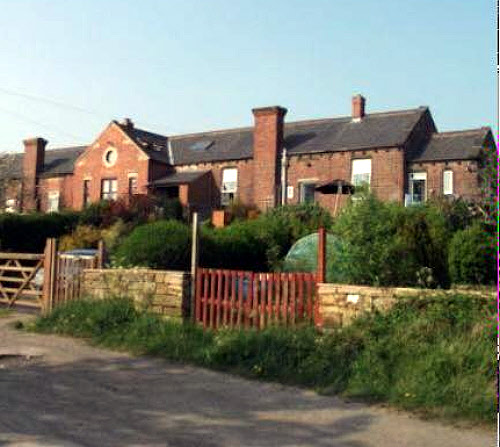
Above: The conversion of the Isolation Hospital into houses.
In September 1950, it was decided that the rents for the new homes in the hospital would be the same as for the new houses being constructed in the estate off Love Lane (Holme Leas Drive estate), where two bed dwellings would be rented at 16/- per week, and three bed dwellings 17/7 per week.
By the end of the year the Council was becoming tired of the delay. Councillor Clark said he was disappointed that the whole scheme was being held up with bureaucracy. At the Council’s meeting of January 31st 1951 it was suggested that maybe the Housing Chairman of the Council should visit the Ministry personally, and if that failed then maybe the matter should be placed in the hands of the local MP, with a request that he should go as far as raising the matter in the House of Commons.
However, Alderman Wilson said he was prepared to go to London, but he had just that day received a letter from the Ministry giving further details of their financial requirements, and he now hoped that things could be resolved in a matter of a few weeks. A month later, at their meeting of Wednesday February 28th 1951, it was stated that permission had at last been received to convert the property into three dwellings.
However, the chosen contractor, Mr H. Barraclough, had to withdraw his tender on account of him having taken on other work. It was decided to advertise for new tenders. It was also later decided that when the conversion was complete the cottage there should be demolished and the resident caretaker rehoused. Meanwhile it was to be repaired.
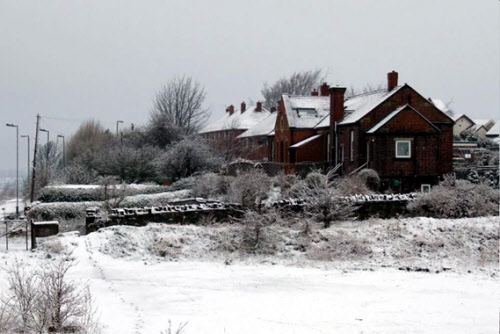
On April 18th at the Council meeting the tender of £2,309 16s 0d from Ossett builder, Mr Gladstone Moorhouse was accepted, subject to the work being completed within a reasonable time. Mr Moorhouse was instructed to begin work at once. Alderman Wilson’s remark at the meeting is a fitting final comment. He said that the building, which was derelict and now being converted into housing, carried the town’s motto: “Useless things by skill made useful”.
LONGLANDS HOUSE, FLUSHDYKE by Rachel Driver
With 12 rooms and its own “plantation” Longlands House was the largest in Ossett, owned and occupied for 100 years or so by Ossett’s richest family, the Haighs. The last of the Longlands Haighs died in the late 1850s but Longlands survived for another 110 years or so until it was demolished in the 1970s.
The house and many outbuildings were situated where the Concorde group now stands, covering at least 16 acres. The house itself, the largest house in Ossett, had 12 rooms. It was ideally placed for its wealthy owner's business as wool staplers.
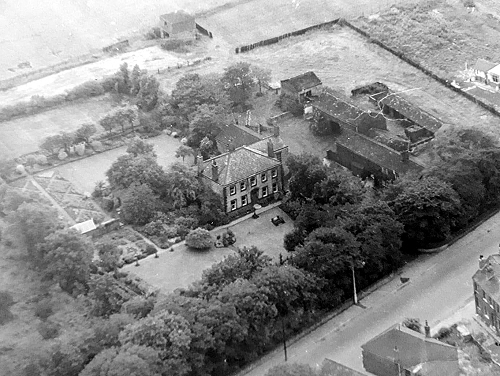
Above: In 1973, demolition began on Longlands Hall and redevelopment commenced. Although pictures of the house were scarce, even then they were only available as partially demolished, until in 2019 a member from Ossett Through the Ages, Jennifer Duckett, provided us with this photograph showing Longlands in its heyday.


Above: Longlands House in the process of being demolished circa 1973.
The trees and perimeter wall still line Wakefield Road and give a good indication of the size of the house and land ownership.
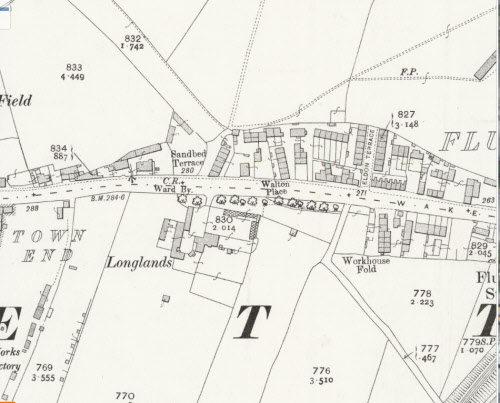
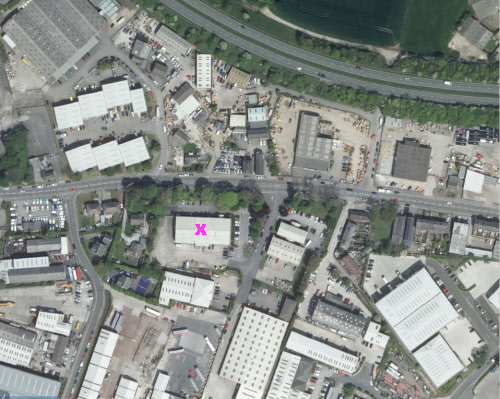
Above: Map of Longlands as it was in the 1920s and a satellite view of the same area in 2021. The cross marks where Longlands House once stood.

Above: The Longlands site in 2021. Concorde House behind the trees.
We have references to Longlands as far back as mid 17th century. This is for the land only, the house is more difficult to date but evidence suggests it was built somewhere between 1746 and 1771.
The house back in 1910 was described by the Inland Revenue Valuation, as having 5 Bedrooms, Box Room, Kitchen, Pantry, Hall, Servants Hall, Dining, Breakfast, Library, with a front and back garden. It had several outbuildings including a 2 bed Coachman’s House and various farm buildings such as barns and stables.
The irony of the placement of this magnificent home is that it’s neighbours were the Ossett Workhouse/poor house who couldn’t live life any more differently to the wealthy Haigh family.
A timeline of the family ownership is listed below.
- 1608 - Longlands land was mentioned in Manor of Wakefield Court Rolls.
- 1664 - John Liversedge inherits one and a half acres at Longlands at his father’s death.
- 1688 - Richard Liversedge sells land from Longlands to John Haigh. The following years it remained in the Haigh family mainly down the male lineage until 1843 when spinster sisters became the owners of 306 acres of land in Ossett.
- 1857 - the last of the sisters died and the estate was left to their cousin, Charles Wheatley who rented out the property until his death in 1900 at which time Longlands was left to his cousin Eleanor Steele.
- 1910 - When Eleanor died, she left Longlands to her son and three spinster daughters. It was rented out to various tenants until 1929, when Mr Crook bought Longlands Hall. These tenants included Abraham Pollard, George Pollard and William Pollard, involved in Mungo Manufacturing and William Speight who was a Woollen Manufacturer.
- 1969, Mr Crook sold 3 acres to Milner Development Ltd for Industrial Development.
- 1971 Mr Crook died and the hall and remaining land was purchased by Milner Development Ltd.
GREEN MOUNT by Rachel Driver
This splendid house has been the home to many Ossett families. It's most famous residing family are the Pickards. Hannah, a most generous and giving woman, is firmly immortalised in the blue plaque erected on the Southdale Road side of the house in 2019.
The family made their wealth through cloth manufacturing. They had originally lived in a cottage on the same land, which Green Mount would later be built on. Although the house is now two separate dwellings, it was originally one house. The Pickard coat of arms is on the ceiling of the old dining room.
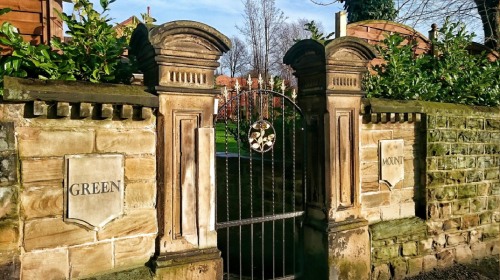
Above: The imposing front gates to Green Mount.
George Pickard married Hannah Mitchell in 1824 and they had four children. Sarah was born in 1826, David in 1830, Andrew in 1835 and Hannah in 1838. This Hannah is the deserved recipient of the blue plaque shown below, which was erected in 2019.

When Hannah died in 1891, she left an incredible legacy, the equivalent of nearly 4 million pounds, that both local and beyond were to benefit from greatly. These included local churches, hospitals, schools, lifeboats, children's homes and many, many more. Her siblings had died previously. Sarah died somewhere between 1841 and 1851 in her teens. David died in 1882 and Andrew died in 1890. To the left on Green Mount was the Congregational Church where the family worshipped. There were two dedicated stained glass windows for both Andrew and herself. The Church was demolished in the 70s and the windows have not been seen since.
Hannah was buried in the long gone Radley Street burial ground, facing her beloved home. Sadly she was unceremoniously dug up, along with approximately 160 other bodies and re-buried under the cover of darkness into a mass grave in Gawthorpe.
To the right of Green Mount is Sowood House, which was the former home of John Greenwood, a well renowned surgeon.

Above: Rear view of Green Mount. Photograph by Stephen Wilson.
In the early 1900s, Green Mount was under the ownership of William Greenwood although the Briggs family were the tenants and they had a small zoo on the premises where they kept birds, a donkey and various other animals. This imposing family home has been a happy home for many, myself included. It has a solid feel of quality, and holds many memories in its remaining original features.
Ossett History
- In Utile ex Arte
- Oslaset - Origins
- Domesday & Beyond
- 14th & 15th Centuries
- 16th & 17th Centuries
- 18th Century
- 19th Century
- 20th Century
Ossett Heritage
- Ossett People
- Ossett Academy
- Ossett Spa
- Ossett Water
- Ossett Collieries
- Ossett Houses
- Ossett Mills
- Gawthorpe
- Healey & Millbank
- Low Laithes
- Mark Senior
- Eli Marsden Wilson
- Flushdyke Sketches
- Brammer's Ossett Sketches
- Ossett Virtual Blue Plaque Scheme
Kids Corner
Green Park 
Links
The Valuation Record that was carried out in Ossett in 1774 was used ultimately to raise taxes for a war against France. France had used the occasion of the War of American Independence (1775–1783) to weaken Britain, its arch-rival in European and world affairs. Independence for the colonies would seriously damage the British Empire and affirm the United States as a rising power, that could be allied with France.
The French entered the war in 1777, and assisted in the victory of the Americans seeking independence from Britain (realized in the 1783 Treaty of Paris). The blockade of Chesapeake Bay in 1781 by the French fleet effectively decided the war, as the British fleet was unable to relieve Cornwallis' troops under siege at Yorktown. Also, in 1783, Britain ceded Senegal back to France.
France's status as a great modern power was affirmed and its taste for revenge for the loss of Canada was satisfied. Even though French cities avoided any direct destruction in the war against Britain, there was a huge financial cost, which caused significant difficulties to the French. Worse still, France’s hope to become the first commercial partner of the newly-established United States was not realized, and Britain immediately became the United States’ main trade partner.
Andrew Pickard of Green Mount, Ossett
When Andrew Pickard died in 1890, he left a fortune of nearly £200,000, mostly to his sister Hannah Pickard but with some placed in trust for his late brother's adopted son George Pickard, who lived at Green Mount with Andrew and Hannah.
Andrew Pickard also left £1,000 to each of his the children of his mother's brother Robert Mitchell. These first cousins were named as James Mitchell, Robert Mitchell, Benjamin Mitchell, Sarah Mitchell, Ellen Dews, Hannah Fisher, Mary Kershaw, Charlotte Hemingway and Martha Mitchell. He also left £1,000 to his 'old nurse' Susan Dews of Ossett Common. Andrew also bequeathed funds for the provision of five lifeboats to be named "George Pickard, Hannah Pickard, Sarah Pickard, David Pickard and Andrew Pickard."

The first lifeboat to built from Pickard's legacy was the "George Pickard", which was commissioned in 1893 at a cost of £489 4s 0d and saw service at the Scottish fishing port of Peterhead, near Aberdeen. The "George Pickard" was lifeboat number 342 and saw service between the 29th March 1893 and the 2nd April 1897 during which time, the boat saved seven lives. The length of the "George Pickard" was 38ft with a beam of 8ft and it weighed in at 4 tons 3 cwt. Propulsion was by 12 oars!
The second lifeboat to be built was also named "George Pickard" and also saw service at Peterhead between the 2nd April 1897 and the 3rd May 1928 during which time the boat saved 50 lives. The new lifeboat, numbered 400, cost £603 10s 6d and was 37ft long with a beam of 9ft 3", a weight of 4 tons 16 cwt and this time the propulsion was by a mast with sails and 10 oars.
The "George Pickard" was sold in 1928 to a Peterhead man, Alexander Davidson for £38. It was recently reported (2007) in the Newcastle press that "the former Peterhead (Scotland) lifeboat, the "George Pickard", which was built in 1897 has sunk on Newcastle's quayside and is presently causing a navigation hazard. Before it sank, it was thought to be the oldest lifeboat still afloat. It had been converted into a day boat for rod fishing, an engine having been fitted, as originally it was powered by oars and human strength."
David Pickard anecdote
I'm not sure of the origin of this anecdote, but it dates back to the period when David Pickard was in partnership with Mark Wilby at Manor Mill, so it is probably circa 1880, a couple of years before he died.
Pickard went into the hay chamber at Manor Mill where his teamer was busy chopping hay for the horses. Mr. Pickard said "Let me twine for a bit" and the man instantly obeyed. Mr. Pickard had only been twining for a few minutes when he stopped, so the teamer said "Nay, go on", and Mr. Pickard, who by then had had enough, said "Nay lad, I am not forced." This was absolutely true of course; Pickard was not forced.
Hannah Pickard died on the 29th June 1891, leaving £140,000. The majority of her estate went to her adopted nephew George Pickard, who himself was to die in 1892. However, Hannah was to leave a long list of legacies to various people and organisations as follows: to widow Elizabeth Nettleton £2,000; to John Pickard of Dishforth £1,000, the widow of Simeon Pickard of Sunderland £1,000; the same sum to each of my nine cousins, the children of my uncle Robert Mitchell.
She also left in her Will £34,950 in total to many charitable legacies to organisations including Leeds General Infirmary; Clayton Hospital, Wakefield; Wakefield Dispensary; The Ossett Green Congregational Church; the Primitive Methodist Church, Queen Street, Ossett; the Baptist Chapel, Ossett Common; the Wesleyan Chapel, Ossett Common. In addition she left £500 for the erection of "a drinking fountain and water trough for the use of horses and dogs" in the Market Place, Ossett. Hannah also left money for two stained glass windows at Ossett Congregational Church and £2,100 was left to Ossett Grammar School for two "Pickard Scholarships". Another £50 was left to Alfred Pickard of Darlington.
Her household effects were left to her adopted nephew George Pickard and £10,000 to his wife, if he should marry and "if the trustees are satisfied with her." To James Mitchell, the eldest son of her uncle Robert (Mitchell), she gave three cottages adjoining her uncle's house on Low Common and to her cousin Sarah Scott (daughter of Robert Mitchell), she left a house, a barn and two closes of land on Ossett Common. The late Andrew Pickard's mill on Aire Street in Leeds was left to John Jowett Jackson, who was the mill manager, with instructions to the effect that no trade in the name of Pickard was to be continued there or at Manor Mill, Healey.

Obituary Edward Clay 1844-1921
We regret to record the death, which took place at his residence, Wesley House, Ossett on Sunday, of Mr. Edward Clay, J.P. His passing away removes one who for some 40 years took a leading part in the affairs of the town and whose career of public service has not been surpassed by any of its citizens. During a vital period in the history of the borough, his activities counted for a great deal, and he had outlived almost all those with whom he was associated in carrying out a great many of the improvements, which have the made the town what it is today. Unfortunately his retirement from public work, about 15 years ago, was clouded with a tragic breakdown in health, which precluded him from taking any further part in social life, although his familiar figure was to be seen in the street until a short time ago. A man of determined will and forceful character, he occupied a commanding place in many spheres for a long period, and his career should be an inspiring example to many of the younger generation to whom his was all but unknown.
The deceased gentleman was the son of Mr. Jacob Clay, who formerly kept the Carpenter's Arms Hotel, Bank Street. In early manhood, he was, like so many others who afterward became prominent citizens in the town , a handloom weaver and also for a short time, held an appointment under the Board of Surveyors, which then administered the affairs of the township. Later, when that trade was beginning to develop, he commenced business as a rag merchant and mungo manufacturer. This proved very successful and the business is still carried on under the name of Edward Clay and Son, Limited. Mr. Clay was also a partner in the late firm of Giggal and Clay, wool extractors, Healey New Mill. Nearly 30 years ago, he purchased the Wesley House estate, where he has since resided.
In comparatively early life, the deceased gentleman showed a keen public spirit and interest in the welfare and progress of Ossett and was one of the honorary secretaries of the old Mechanics' Institute about 50 years ago. He was first elected as a member of the old Local Board in 1877, and re-elected on three subsequent occasions, and during his period of office, twice occupied the chair. He was one of the chief instigators of the movement, which led to the incorporation of the borough in 1890, and proof of his popularity is evidenced by the fact that on the granting of the charter he was returned by the highest number of votes given to any of the aspirants for seats on the first town council, and also elected by his fellow members as the first mayor of the borough and one of the first aldermen. His first term of office as mayor which was repeated again for another year in 1893/94 was a notable one in many ways and fortified by his ripe experience and grasp of public work, he carried out the duties of the office with distinction and ability. In 1900, Mr. Clay was re-appointed as an alderman for a further six years, at the end of which period he definitely retired from public life. During his career on the local board and town council, he was closely identified with many of the principal improvements which materially changed the outward aspect of the borough, including the making of Station Road. He was also one of the prime movers in obtaining a commission of the peace for the borough and was appointed one of the first twelve magistrates, of whom, it may be mentioned, he was the last survivor. In 1882, Mr. Clay served as a guardian of the poor and he was overseer for some years. He also held the presidency of the Chamber of Commerce on two occasions. An ardent politician, he was for a long period a member of the Liberal Club and also president of the Liberal Association. He was closely identified with the Wesley Street Wesleyan Chapel and for many years a teacher in the Sunday school. His influence and support were always readily given to any good cause, including music and cricket, and he was a teetotaller.
The deceased is survived by his widow (his second wife) and two married daughters. His two sons pre-deceased him, and sad to relate, his eldest daughter, Mrs. Arthur Jessop, died on Thursday after a long illness.
The interment took place in the Wesleyan Burial Ground, South Parade on Wednesday afternoon amid every sign of sympathy and respect, the attendance including representatives of various public bodies and movements with which the deceased gentleman had been associated, viz., Ossett Town Council, Chamber of Commerce, Liberal Club, the local magisterial bench, cricket club, Wesleyan Church, etc.
From the 'Ossett Observer' 14th May 1921
Death of Mr. Edward Clay 1898-1979
Head of an old family manufacturing firm in Ossett, Mr. Edward (Wilson) Clay, of Wesley House died early on Tuesday morning aged 81. A grandson of of Ossett's first mayor of the same name, Mr. Clay recently retired as head of the firm, Edward Clay and Sons, who were formerly mungo and shoddy manufacturers and now flock fillings.
After service in WW1 in the R.A.S.C. he returned to the firm and in the 1920s was a prominent member of an Ossett amateur variety troupe who gave many shows on behalf of charities. A talented pianist, Mr Clay was an old member of the Wesley Street Methodist Church, where he was a trustee and on occasions, acted as organist. He served for a short time as a co-opted member of Ossett Town Council during WW2, but otherwise took no part in public life.
He is survived by his wife and two sons, (John and Anthony) , daughters-in-law and six grandchildren.
From the 'Ossett Observer' 5th May 1979
The Land Tax Records 1781-1832
The Land Tax was introduced in England in the early 1780s in order to raise taxes for the War with the French. The tax was based on property values and as such it was necessary to conduct a survey of those properties. In the early years of the tax the annual survey appears to have been undertaken by a collector walking a route and recording the properties as he came across them. In later years the records are maintained in alphabetic order. The record shows the owner and occupier of the property but rarely indicates whether there was structures of any sort on the land being surveyed. The value of each piece of land is multiplied by a rate in the pound and the product is the amount paid by the owner.
In Ossett’s case the records exist for most years between 1781 and the mid 1830’s and whilst they are useful in providing evidence of names and ownership they are less helpful in determining the location of the land or property and of no help at all in terms of discovering whether there was property on the site.
The Wakefield Manorial Court Rolls
These original Rolls are maintained by The Yorkshire Archaeological Society (YAS) at Claremont House, Clarendon Road. Leeds.
Ossett Survey and Valuation of 1774
Currently held in the private collection of local historian John Goodchild. It is not known if any other copy of this important document exists.
Samuel Scott was born in Ossett in about 1780. In the 1841 Census he is described as a clothier, 60 years old and living on Middle Common ( Park Square and the adjacent area) with his 45 year old wife wife Catherine ( nee Castyle born the daughter of a joiner of Kirkbride in the Isle of Man). They have one son; 7 year old Henry (born about 1834).
Later Censuses, through to 1901 (the most recent ones publicly available) also show the Scotts in Middle Common and hence it seems probable that if the Scotts ever lived at Scott’s Yard then they did so prior to 1841 and certainly not after that date.
By 1851 Samuel, Catherine and Henry are still living on Middle Common. Samuel is now 72 and a retired Cloth Manufacturer.
Henry Castille Scott is 16 and already “a clothier”. Living with them, at least on the night of the census, is a general servant and Abraham Scott a 51year old Licensed Victualler.
Samuel Scott died in the second half of 1860 and there is no record of his wife Catherine in the census of 1861, suggesting that she too may have died in the 1850’s. Henry Castile Scott and Hannah Briggs (daughter of Cloth Manufacturer George Briggs) were married in 1857 (April quarter) and by 1861 the 27 year old Henry and 31year old Hannah have two young girls; 2 year old Catherine Castyle Scott and 10 month old Georgiana. Henry is described as a “woollen cloth manufacturer of the firm George Briggs and Sons”.
The Scotts are living on Middle Common to the east of Giggal Hill and Scott’s Yard. It seems probable that Middle Common, largely the area now known as Park Square, was home for professional, one might say middle class, families whilst properties to the west including Giggal Hill and Scotts Yard provided less grand accommodation for working class families. An examination of the 1854 map reveals no housing on the Manor Road frontage to Middle Common whereas the 1890 map shows housing including the substantial Mona Cottage set in its own one acre of land.
In 1871 Henry appears in the Census living in Mona Cottage on Middle Common. It is possible that the Scotts built the Cottage, around this time, on land that they already owned. Woollen Cloth Manufacturer Henry is now aged 36 and a widower. He is living with his 10 year old daughter, Georgiana and a 37 year old unmarried servant, Jane Whitaker. His close neighbours include a farmer and a rag merchant.
By the time of her death in 1869, aged 38, Henry’s wife, Hannah had given birth to five children all under the age of 11 at her death. In addition to Georgiana living with her father on census night, the other children were Catherine Castyle Scott (born 1859), George Henry Scott (1862), Anna Louisa (1864) and Sam Castile Scott (1868).
In 1871 Catherine, George and Sam were living with their 76 year old widowed grandmother, (also called) Hannah Briggs on Denton Lane. Hannah’s married son, George (aged 38) and unmarried son Oliver(36) are also shown in Hannah’s household which is completed by 17 year old grandchild Anna Rhodes (Farmer’s daughter). George and Oliver are described as Cloth Manufacturers “employ 30 men 111 women”. In 1871 there is no sign of 7 year old Anna Louisa in either her father’s or grandmother’s home.
By 1881 four of the Scott children are reunited with their father at “Manor Road Mona Cottage”. 46 year old widower Henry is described as a “woollen manufacturer (retired). Maybe he had taken some time off work to bring up his children. They have one servant. 20 year old Henry George Scott is a medical student. 17 year old Anna Louisa is recorded at 94 Sackville Street Barnsley as one of two pupils living with Headmistress Elizabeth Corfield.
In 1891 Henry senior is aged 56, a woollen cloth manufacturer, with an address as Park Square (but probably still Mona Cottage). His daughter Anna Louisa and son Sam Castyle are also living here. His other son, 29 year old Henry George, is a Doctor living in Sheffield with his sister Catherine. Georgiana is recorded as being at The Vicarage Lanlivery in Cornwall; the home of the Vicar of Lanlivery, Francis Kendall.
In 1901, the last of the currently available censuses, 66 year old Henry Castile Scott is still living in Mona Cottage and with him are three of his children; Georgiana Scott (aged 40), Anna Louisa Scott (37) and Sam Castile Scott (33). His son Henry George Scott is a Physician and surgeon living in Sheffield with his wife and three children (all under 5) They have four servants. It seems the boy done good. Catherine is not shown in the 1901 census, but her father’s Will, made in 1905, makes reference to only four of his children and there is no reference to Catherine. These two facts suggest she died sometime between March 1891 and March 1901.
Henry Castile Scott died on the 3rd May 1912 aged 78. Four of his children were living at the time of his death. Doctor George Henry Scott died on the 3 January 1924 aged 62; Georgiana Scott died on 26 September 1934 aged 74; Sam Castile Scott died 13 September 1935 aged 67 and Anna Louise Scott survived them all and died, aged 78, on the 3rd January 1943. Only George Henry Scott was to marry and have children. In the 1901 Census he is father to Henry W Scott (born 1896), Arthur G. Scott (born 1897) and John Winterton Scott (born 1898).
John Winterton Scott was joint executor of his aunt Anna Louisa Scott’s Will and it was he who was to sell Scotts Yard to Alfred Arthur Ellis in February 1943.
OBITUARY - MARK WILBY OF MANOR MILLS AND MANOR HOUSE - 1912
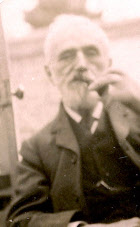
The death occurred yesterday morning at his residence "Beechwood", Hampton Road, Southport, of a well-known Ossett gentleman, Mr. Mark Wilby, who had reached the advanced age of 85 years. His end was not unexpected. Though until a few years ago a remarkably robust and strong man for his age, he had for some time been in a serious state of health. The weakness caused by old age had been increased by failing eyesight. An operation performed a short time ago left him completely blind and that no doubt hastened his death.
The late Mr. Wilby was a member of a family which for generations before him was engaged in the trade, which was once Ossett's staple industry; that of cloth weaving. We believe he represented at least the fourth generation of cloth manufacturers or clothiers as they were described in his young days. Before the discovery of the process of reconverting rags into wool had given given rise to the rag and shoddy trade, which in Ossett has largely displaced cloth manufacture as the chief textile industry, he was a hand loom weaver, as his ancestors had been. In an after-dinner speech, he once said that he recollected a time when there were no rags sorted in Ossett and not a pound of mungo ground. When Ossett led Morley, Batley and Dewsbury in cloth manufacture and when it was impossible to walk fifty yards in the town without hearing the click of the shuttles of the hand looms. With the advent of power loom weaving, he became a cloth manufacturer in a large way of business, occupying Manor Mills and amassing considerable wealth. One of the hard-headed, frugal type of Yorkshireman, even in the days of his prosperity, he lived in a cottage in Park Square, until he built Manor House, the large residence near the mills, where he lived until he retired from business. He ceased cloth production during a period of low prices and, strong-willed as he always was, he held for some time, unwisely as it proved, a large stock of cloth in the hope of recovery, the realisation of which involved him in serious loss. In connection with his business, he was a trustee of the old Leeds White Cloth Hall and we believe he was president in the year of its dissolution in 1896.
In local affairs, the deceased gentleman took his part and had a distinction, which no other man could claim. When the Ossett Board of Surveyors was formed, he was one of its first members , though he did not continue in office for many years. He was elected a member of the Local Board on the formation of that body in 1871. Again, he did not sit long retiring when his first term of office expired. But when the Charter of Incorporation was granted in 1890 and the first town council was elected, he was again a successful candidate so that he was one of the first members of the Board of Surveyors, Local Board and Corporation in turn, although on none of these bodies had he a long period of service. In the Board of Surveyor days, he was one of the active opponents of the adoption of the Local Government Act, a preliminary to the formation of the Local Board of Health. He had his ideas for the improvement of the town, for we gather from an election address:
"When in office on the Board of Surveyors, I made several suggestions which, if they had been carried out, would have put Ossett in a deal better position than it is today. I suggested that we should make a road from Field Lane (Church Street), down Intake Lane, right down Sowood Lane to Horbury Road." Another suggestion made was that until the Ossett Gas Company were prepared to transfer ownership of the works to the Local Board, then the latter should refuse to allow the town to be lighted by gas. It is worth recalling that in the first Local Board election, in which he was successful, there were 35 candidates for 15 seats and the voting paper was 47 inches long. The "promoters" of the Local Government Act carried 11 seats and the opposition of whom Mr. Wilby was one, secured just four seats, though three of the "opponents" were near the top of the poll, Mr. Wilby was sixth in the list with 1065 votes. Mr. Joshua Speight being top with 1185 votes.
The late Mr. Wilby is survived by four daughters and one son. One of the daughters is an ex-mayoress of Ossett, the wife of Alderman T.W. Phillips and another is the wife of Mr. J.W. Cussons, formerly of Ossett.
Joan P. Smith
Ossett historian, is the author of the Highfield House article.
Fourteen years ago Joan was involved in the formation of the Wakefield & District Family History Society, serving as the first General Secretary, Vice Chairman and finally as Projects Co-ordinator. In this role she was instrumental in the publishing of about 350 booklets. In 2005, Joan, received Life Membership of Wakefield & District Family History Society, from the Patron, Lord St. Oswald.

Above: Joan P. Smith in 2010
Joan lives in Ossett, close to Trinity Church and is married to Stuart, who she says encourages her hobbies and never expects meals to be "on the table" or work surfaces to be dust free.
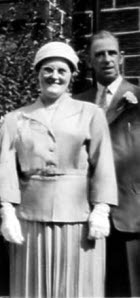
Above: Joan's parents George & Nellie Worth, owners of Highfield Cottage pictured in 1957.
As part of Joan's write-up on Highfield, she has provided an excellent description of the cloth making industry that was so common in Ossett in the 18th and 19th centuries:
Weaving With Wool
The fleece from different kinds of sheep with various weaving methods was used to create different types of cloth:
Worsted was made from smooth, compactly spun yarn and used for clothing.
Wool(l)en’ was made from fuzzy, loosely spun yarn and used for heavy clothing and blankets.
Shoddy was made from a mixture of recycled wool(l)en rags and virgin wool and treated like wool(l)en.
The washed fleece was processed on hand looms to produce woollen and worsted cloth in roughly the same way.
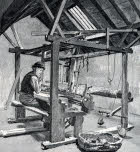
Above: Hand Loom weaver in 1888. John Harrop was a cloth manufacturer and all his sons were weavers. In his Will he mentions his dwelling house, shop (weaving shop), stable and other outbuildings; also his stand in the Cloth Hall at Leeds.
Weaving
Warp threads were tied onto the loom. They were then passed through a reed, which kept them in order and served as a beater after the weft or cross thread was passed. After the warp threads were threaded through the reed, they were passed through ‘heddles’, which allowed the weaver to raise and lower different warp threads. Weft threads were ‘shot’ or ‘thrown’ across the warp threads. The cloth was ‘beaten’, (packed towards the already completed part of the cloth), after each shot of weft thread. Alternating weft threads were raised and lowered after each shot of weft thread. When the cloth was finished it was removed from the loom.
On the census a man’s occupation was often described as a ‘Clothier’. This could be one man and his family, who together performed most of the steps of cloth making; a person who employed up to 30 weavers or something in between. The majority of clothiers were not large manufacturers. They often did a little farming on the side, mainly raising vegetables and crops that did not require a lot of attention. Attached to the clothier's cottage was a piece of land that ranged in size from one to fifteen acres. The clothier usually kept some animals; poultry, pigs, a cow or two, a horse and/or an ass.
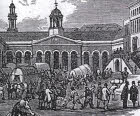
Above: Leeds Cloth Hall
The small clothier, assisted by his son or apprentice, warped the loom and did the weaving. After the cloth was woven it was taken to the fulling mill. When the cloth was dry, the clothier put his cloth on his horse or donkey, or carried the cloth on his own back and brought the cloth to the market towns, where he sold it. There was still work to be done on the cloth after the fulling, but the clothier sold the cloth in the "rough" and left the finishing to the cloth finisher. The major markets for the cloth were in Leeds and Halifax.
JOSEPH COX (1833 - 1906) by Joan P. Smith
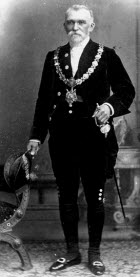
Above: Joseph Cox, the second Mayor of Ossett from 1896 to 1897, when he visited Buckingham Palace on the occasion of Queen Victoria’s Golden Jubilee.
Joseph Cox retired from his position as Headmaster of South Ossett school (sometimes affectionately referred to by ex pupils as ‘Cox’s College’) on 10th November 1899 after almost 40 years dedicated service. He helped out again in 1900 and acted as a School Manager for the next six years. He died on 17th and was buried on 21st September 1906. His wife Sarah survived him by only 8 months and was buried on the 6th May 1907. They lived on Storrs Hill Rd., Ossett and their burial services took place at Holy Trinity Church. They were both aged 72 years.
Joseph Cox was born circa 1833 and baptised 4th Nov 1833 in Holme-upon-Spalding Moor, Yorkshire; the son of John Cox, an agricultural labourer and Jane Billingham, (who were married in Holme on Spalding 10th February 1829) . In the 1851 census Joseph was aged 17, living with his parents, his occupation being given as a ‘scholar’! This suggests that he may have been studying whilst working, (possibly a correspondence course or even as a Pupil Teacher), but this would have not earned much, if any, money to contribute to the family of an agricultural worker. Perhaps we will never know the answer to this but he was evidently very clever and gained his qualifications to be a teacher.
Joseph, aged 24 married Sarah Anelay, born circa 1834 and baptised 11th Jan 1835 in Eastrington, aged 22 between July & September 1857 (registered in Howden).
Sarah’s family were also agricultural labourers, and in the 1851 census she is described as a “servant”. Joseph evidently gained sufficient teaching experience during the next 10 years to be offered the post of Headmaster of South Ossett Christ Church School in 1859. Sarah was also installed as Schoolmistress. Perhaps she was taught by Joseph? She was an experienced needlewoman, possibly learning this skill when she worked as a servant.
Sarah Cox must have been an exceptional ‘working mother’ as over the next 20 years she produced 13 children:
Annie, 1858; Frederick 1859; Eleanor 1860; Lizzie 1862; Bertram 1863; Emily 1864; Mary Jane 1866; Gertrude 1868; Ernest George 1869; Harry Anelay 1872 (who lived at Sowood House); Florence Edith 1873; Catherine Maud 1874 and Sydney 1877.
This was in addition to teaching needlework in the school. How she coped with the demands of a mother, especially nursing the children through the usual childhood illnesses prevalent at that time, such as Scarletina (Rubella) Chicken Pox, Small Pox and Measles, it is hard to imagine. In 1864 the three youngest children were very ill. Two of the children died in the space of 8 days. Bertram was buried on Oct 12th aged 16 months and Lizzie on Oct 20th aged 30 months. Amazingly baby Emily aged 3 months survived.
Joseph and Sarah’s daughters Annie, Emily, Mary Jane, Gertrude and Catherine Maud all followed in their parents’ footsteps and became teachers.
Two of his sons Sidney and Ernest were ironmongers.
His son Harry Anelay Cox was a clerk but later became a Rag Merchant with large premises in Dewsbury.)
Mary Jane Cox married Samuel Norman Pickard on 17 Oct 1893 in South Ossett Christ Church and Harry Anelay Cox was later known to have lived in Highfield Cottage in 1907 when it was owned by Alfred Hinchliffe Pickard. He later purchased Sowood House from Lois Pickard.
VICARS OF SOUTH OSSETT Church

1851 – 1884 Denis Creighton NEARY, DD, Trinity College Dublin. Died March 15th 1884.
The first Vicar Mr Neary took a weaving chamber belonging to Mr George Wilby (father of Mark Wilby of Manor House & Manor Mill) to use for Church Meetings. The chamber is still standing but has now been made into cottages. Mr Neary prevailed upon Mr Joseph Thornes of Green House to give him a piece of ground bordering on Horbury Lane; approximately 2 acres of rough field with a small straw thatched cottage in possession of an old woman named Martha Giggal, who was reluctant to move but was persuaded by being offered £22 in compensation! The Foundation Stone for South Ossett Church was laid Jan 1st 1851 and the Church Consecrated on Oct 16th 1851
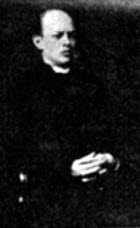
1884 – 1892 John Henry WARD, MA, Keble College Oxford. 1892 appointed Vicar of Earlsheaton. Died Feb 22 1894.

1892 – 1911 John Henry KIRK, BA Cambridge. 1911 appointed Vicar of Wrenthorpe.

1911 – 1935 Alfred Lee BURNHAM, MA, Magdalen College, Oxford (Former Curate of Almondbury) Installed March 15th 1911. 1935 – 1939 Vicar of Stottezdon? Died 1950.
1935 – 1944 Douglas Oxby PARKER MA (BA Man) Wycliffe Hall, Oxford. Vicar of Whitechapel. 1944 – Vicar of Acomb, York.
1944 – 1955 John FIRTH Lth? Durham. Vicar of St John, Thorpe & St Mary Sowerby? 1955 appointed Vicar of Clifton, near Brighouse
1956 - Henry Rosslyn HAWORTH MA Selwyn? College Cambridge. BSc, London. BD Leeds. Vicar of Featherstone.